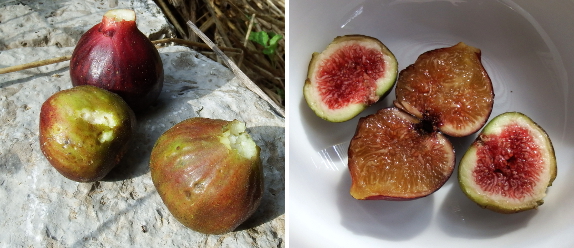
archives for 09/2015
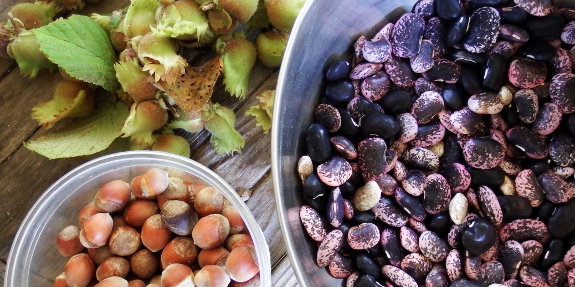
Another Monday, another big harvest push.
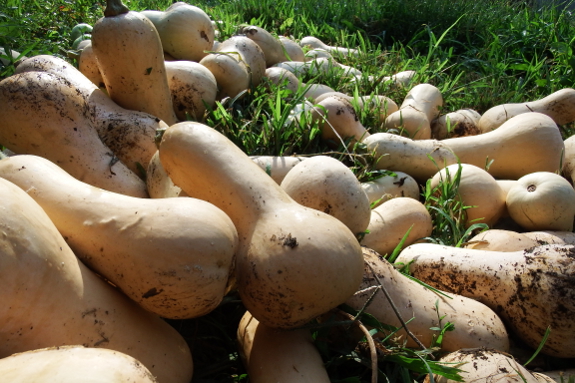
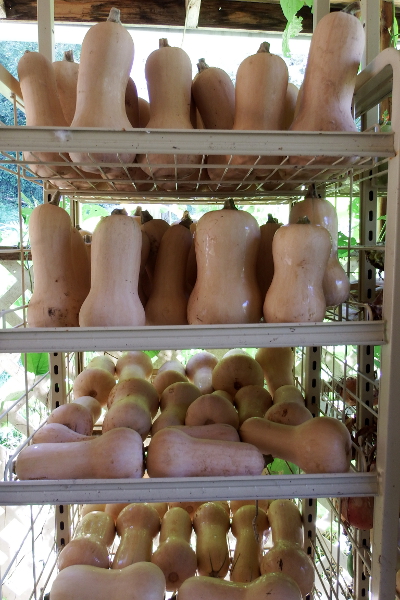 This week, my primary goal was to completely clear out the main butternut patch to make way for planting an oat cover crop.
To that end, I harvested every squash, whether it was ready or not. The
few that were still greenish will go to the goats in the near future, so they won't be wasted.
This week, my primary goal was to completely clear out the main butternut patch to make way for planting an oat cover crop.
To that end, I harvested every squash, whether it was ready or not. The
few that were still greenish will go to the goats in the near future, so they won't be wasted.
With over sixty new
fruits coming in, I had to stand up the previous harvests' butternuts to
make way for this week's graduates. The photo at left shows about
two-thirds of our butternut harvest to date...but I've still got at
least a dozen growing in other parts of the garden.
The good news is that our spoiled goats adore butternuts. Both girls turned up their noses at fresh mangels,
Abigail likes carrots while Artemesia is less sure, but chopped, raw
butternuts disappear down the goat gullet immediately. I guess I now
have about four months of goat concentrates figured out --- excellent!
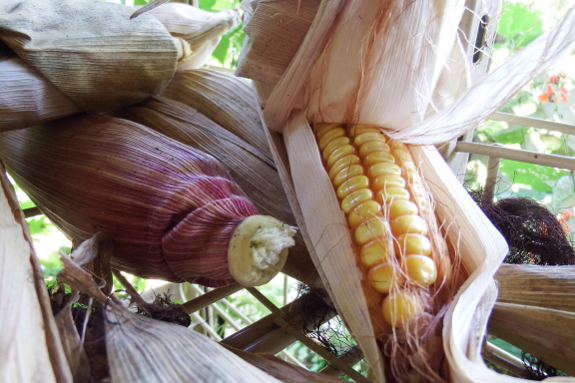
Speaking of goat
concentrates, I also harvested my experimental field corn planting. I
put in a couple of rows of Nothstine Dent corn this spring mostly
because our goats enjoy sweet corn leaves so much. We can only consume
so much sweet corn, but I figured a bit of field corn could either feed
the goats (if I lower my standards), the chickens, or family members who
consume grain. We'll see who these new ears go to and whether the
not-quite-so-sugary leaves are as much like goat candy as those of sweet
corn.
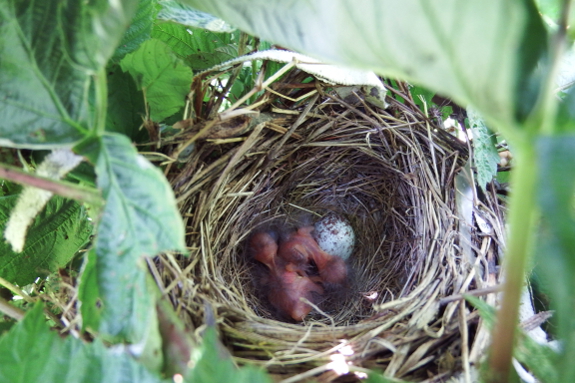
Finally, in unrelated Monday news, Mama Song Sparrow's third hatch
is now underway! Two babies grace her hidden nest, deep in the
raspberry canes, and both are so tiny they have to be sparrows instead
of cowbirds. Here's hoping she has better luck raising her own species
this time around.
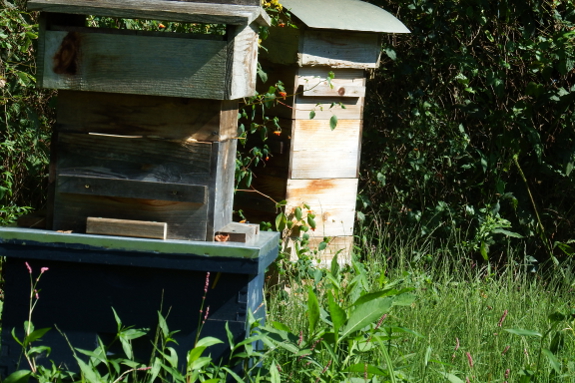
It's always handy when
delving into a bee hive to spend a couple of minutes beforehand thinking
through your goals for the operation. This time around, my plan was
simple --- I wanted to check on the state of our two hives' honey stores
to determine how much sugar water (if any) they need to stock up for the winter.
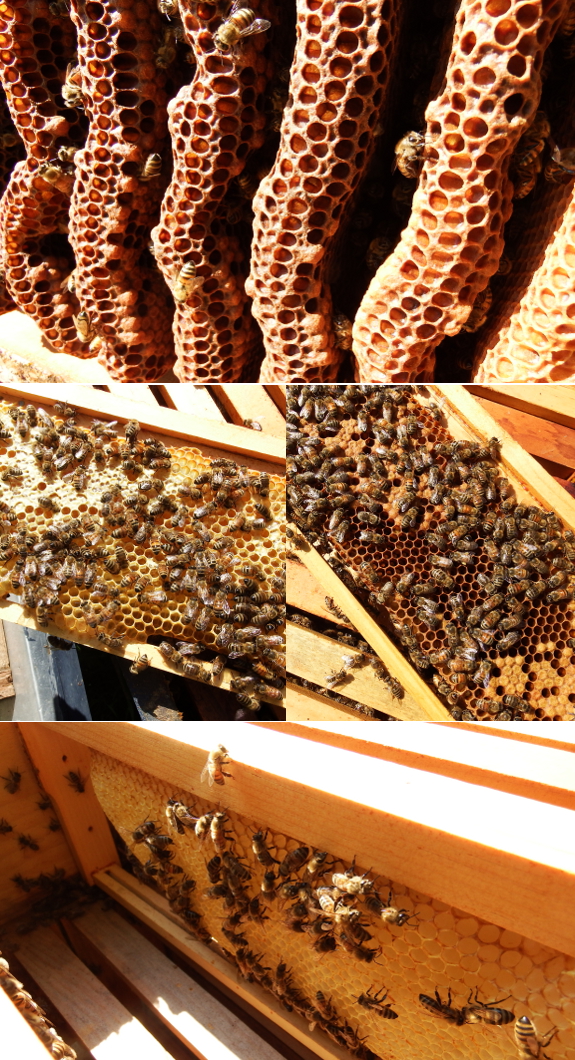
The mother hive is shown
on the left in the first photo in this post, and you can see the
hardware is a weird Langstroth-Warre mixture. As long-term readers know,
I've been trying to convert this colony from Warre to Langstroth boxes all summer, but the queen seems to want to stay up in the Warre box. The top photo in this conglomeration shows that Warre attic --- still disappointingly full of brood.
The good news is that the queen has finally at least started to
lay in the Langstroth hive, suggesting I may be able to finish the
conversion eventually. The two photos in the middle show frames from the
top Langstroth super, some of which contain honey (mostly uncapped) and
some of which contain brood. Yes, there is
a lot less honey present than there was earlier in the summer --- we
always see that pattern with a spring nectar flow followed by a summer
dearth.
The third box from the
top is shown in the bottom photo. The bees are still working on drawing
out comb here, and they haven't even reached the Langstroth basement
(the fourth box from the top).
So, the in-use area of
this hive is primarily two boxes, much of which is brood. Yep, I need to
keep feeding despite the fall nectar flow, and I should probably
increase their ration from once a week to every time they empty the jar.
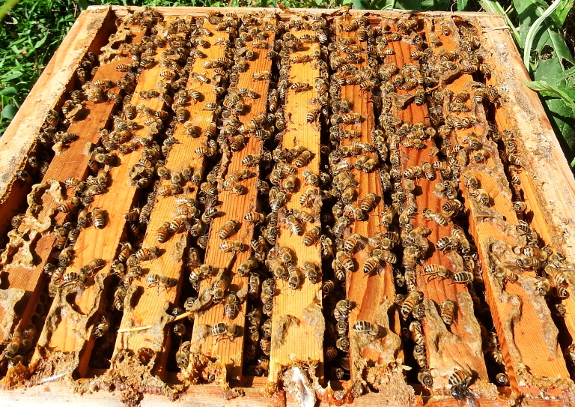
I didn't take as many
photos of the daughter hive since it's much harder to pull out Warre
frames and look inside. Like the mother hive, this colony has four
boxes, and here all of the comb is drawn. But the daughter's attic is
pretty much empty and so is the basement, so the bees are primarily
working in the middle two boxes (just like in the mother hive). Based on
weight, I'd say this colony might survive without feeding, but if I can
track down my second feeder lid I'll probably put these girls back on
the dole too.
I'm always disappointed when I have to feed honeybees, but it's not a
surprise after a split and a swarm in the same year. On the other hand,
it's reassuring to see such large numbers of workers in both hives,
suggesting that if the weather doesn't cool too quickly they may do well
on all of the fall flowers that are currently in bloom. So I'll provide
sugar water and they'll stock up on wild nectar and pollen, and we'll
both dream about honey next year.
My quick tarp
protection lasted a whopping 4 days.
Oh Artemesia.....why do you
have to be so Bad.
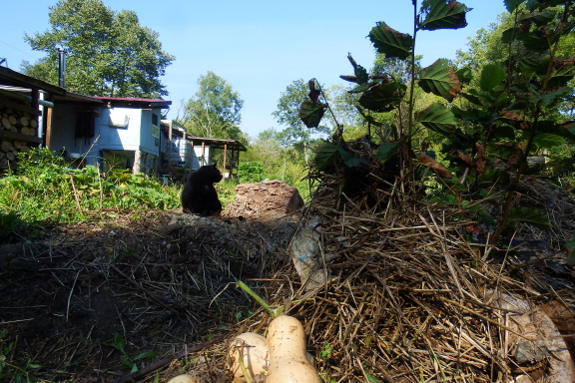
My dirty little secret is
that I'm a workaholic...until you leave me alone on the farm. Then I
have a tendency to curl up with a book and a cat and not emerge for
hours.
Since I had several items on my to-do list to complete while Mark was away at school,
I figured I'd instead take the cat to the garden and see if Huckleberry
is as good at prompting me to work as he is at telling me to play
hookie.
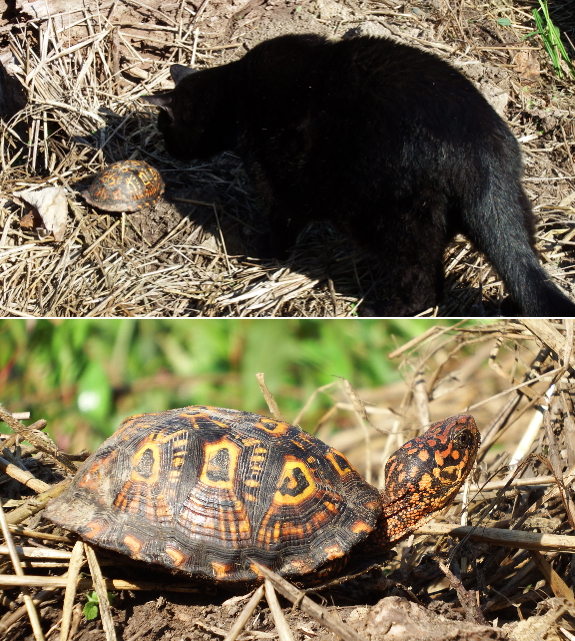
Of course, once I'm outside, the wonder of nature always sucks me in. Tuesday, I was clearing off the butternut beds in preparation for planting oats.
The weeds had grown high in the aisles and the remaining butternut
vines turned this zone into a wild area, so I wasn't entirely surprised
to find a box turtle happily hanging out amid the greenery (along with
seven overlooked squash).
The rings on this
turtle's shell tell me that she's about seven years old (not quite fully
grown), and I amused myself for a while imagining that my totem animal
had hatched right here soon after Mark and I started reclaiming our core
homestead from the wilds. After Huckleberry said hi, I moved the
visitor over under the hazelnut bush, where she can find some peace and
quiet amid the comfrey.
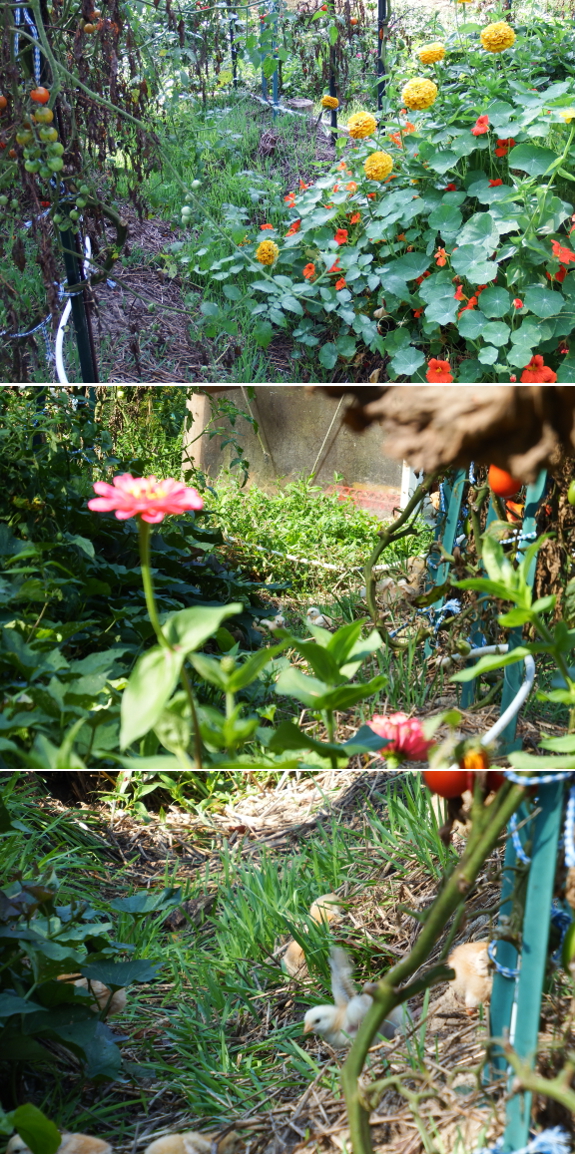
Next door, the broilers
were already hard at work dismantling my earlier planting of oats at the
feet of failing tomato vines. Mark and I put the brooder in this area
because I assumed tiny chicks wouldn't be able to scratch up the plants
before their roots became fully established. Apparently I was wrong! At only
one week old, the Red Rangers
are already prime scratchers, so I may have to write off some of the
cover crops in this zone. Oh well --- no huge loss since we'll get to
eat the meat.
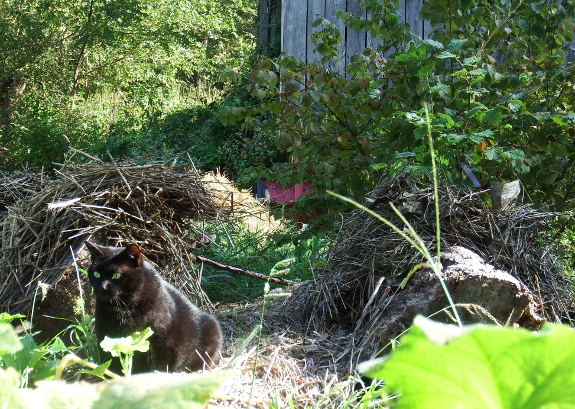
"You're not paying attention to me," complained Huckleberry. "This is boring. I'm going to take a nap."
Good call, cat. I guess it is time for lunch.
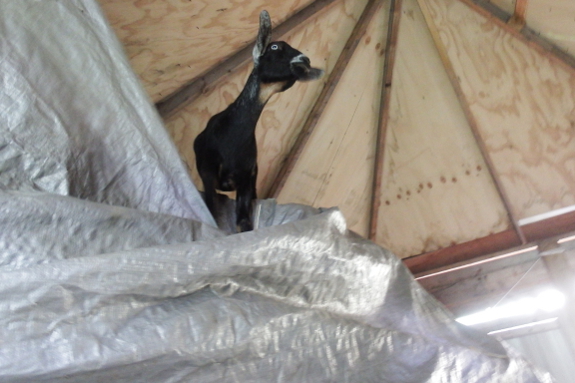
Our goat-jumping problem all started when Abigail informed me that late August grass was far too wet for morning tethering.
Abigail: "Did you ever notice that the words DEW and DEVIL look awfully darn similar?"
Me: "Um, no?"
Abigail: "Well, look it
up! I wouldn't be surprised if they had the same Latin root. And while
you're at it, stop making me wade through damp leaves before my coffee.
Ugh! I'm wet to the knees."
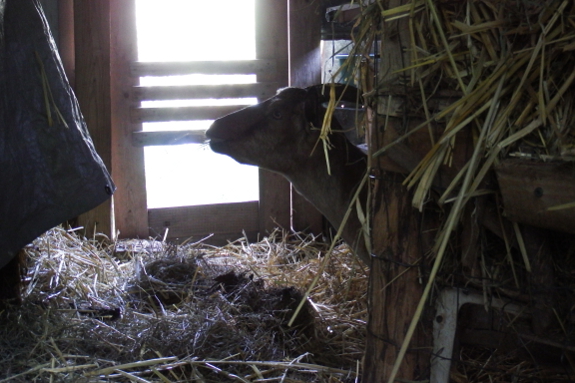
So, in my neverending quest to produce the world's most spoiled herd of two, I conceded to our queen's demand.
Me: "What would you rather eat in the morning, your majesty?"
Abigail: "Sweet corn leaves, hand delivered to my paddock at dawn!"
Me: "You do realize that I
can only feed you sweet corn leaves on the days we harvest sweet corn
ears, right? How about some field corn leaves?"
Abigail: "Hmmph!!"
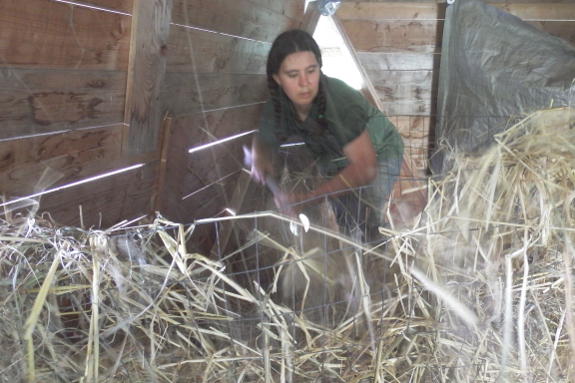
So Abigail and Artemesia
were left in their paddock with only last winter's old hay in their
manger plus sub-par weeds in the pasture. No wonder they wanted to climb
the hay mountain and harvest this year's sweet, dried grasses in the
warm, dry comfort of their coop.
Which made me think that perhaps resolving the feed issue would resolve
the jumping issue. So I hauled every bit of last winter's hay out of the
manger and used it to refresh the goats' bedding. (This isn't as crazy
as it sounds since we bought this batch of "hay" in early spring when
the feed stores were out of real hay and were selling what they called
"wheat grass" instead. In other words, straw with some seed heads in it.
The girls weren't fans.)
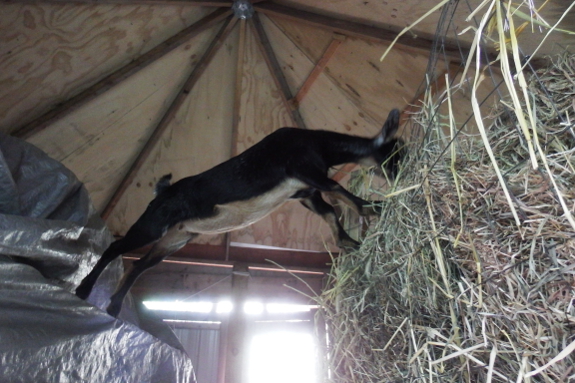
Anyway, with the manger
empty, I filled its cavernous depths with 2015 hay that our girls
appeared to be so enamored with. Then I opened the door so our goats
could explore their new breakfast bar.
Abigail: "Finally! This is the kind of red-carpet treatment I deserve."
Artemesia: "Oh boy! Oh
boy! If I jump up onto the hay pile and streeeetch across, I can eat out
of the manger over top of Abigail's head!"
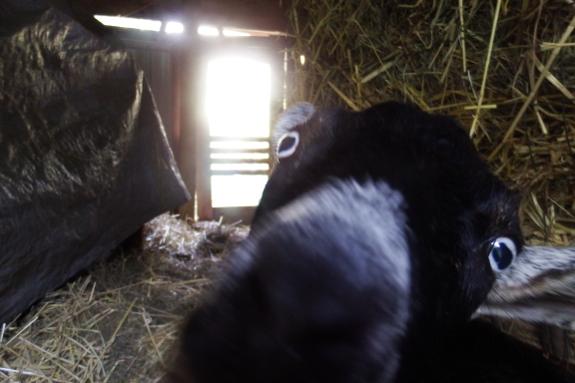
Sigh. It looks like I need to have a chat with our bad doeling and see what makes her tick next. Good thing she's so cute....
We got our roofing tin in
Johnson City at 10 bucks per sheet.
Hauling them back was made
possible by securing a couple of 2x4s to the seat and rack for support
on the bottom.
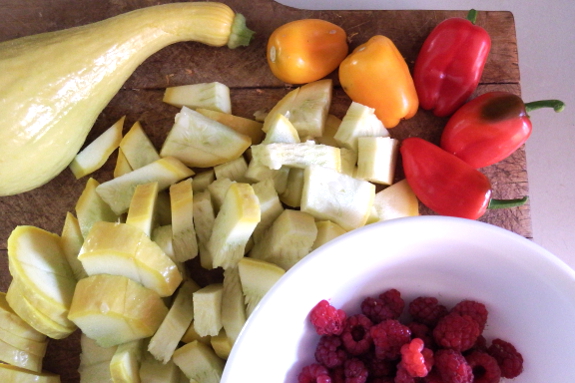
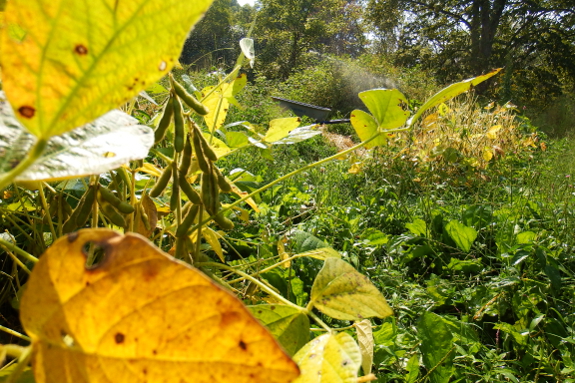
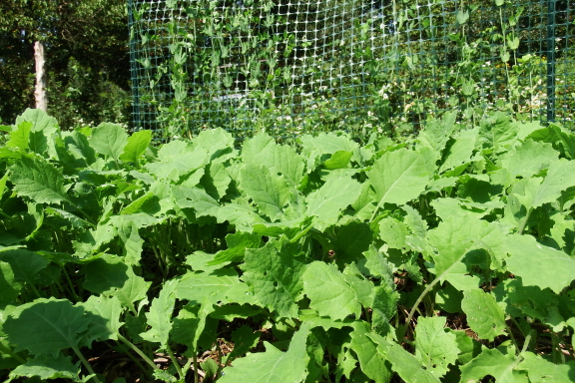
We picked up another load of hay since the goats decided to not eat the old hay.
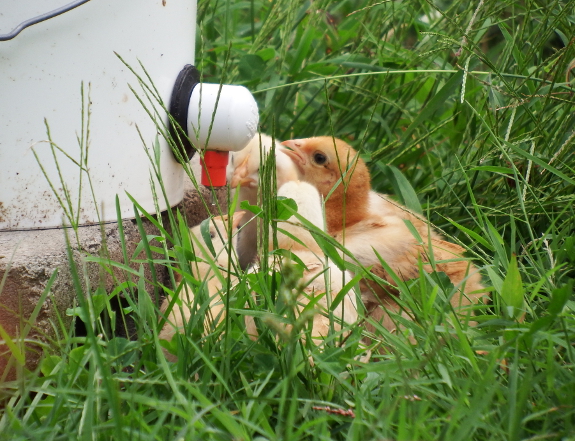
Our Red Rangers
are very industrious. At less than two weeks old, they're already
foraging widely, and I caught one eating a cricket larger than his head.
Unfortunately, their
tendency to roam puts them in harm's way. After my head counts began to
show declining numbers, I assumed the problem was a rat living in the
wood shed. So Mark laboriously helped me heft the brooder up onto the garden cart and haul the chicks' abode around to a safer location right outside the back door.
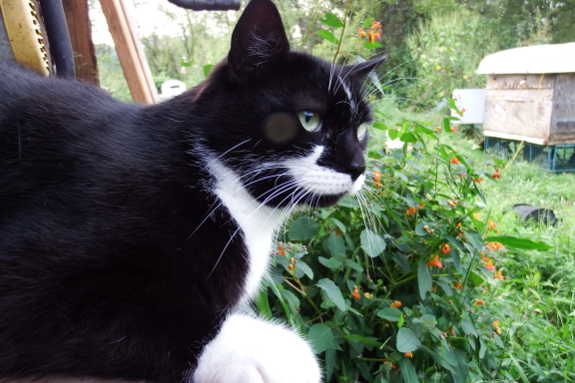
That afternoon, I caught
the predator in action. Not a rat at all, but a sharp-shinned hawk. Too
bad our watch cats aren't quite enough to scare the raptor away. Time to
put on our thinking caps again before our broiler population becomes
any more depleted.
It took 2.5 ratchet straps to secure both 2x4s for the ATV load extension.
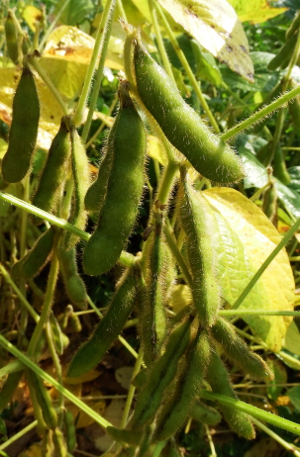 "What will you do with the soybeans?"
"What will you do with the soybeans?"
That's an excellent
question, and one we haven't entirely answered yet ourselves. We planted
the soybeans as a cover crop, and thus pulled up some at the first-bloom stage to act as green manure around sweet corn. (The sweet corn is growing very well, by the way.)
The remaining beds are an
areas slated for fall garlic. But since the soybean pods are nearly
fully mature already and the garlic won't be planted for another couple
of weeks, I'm thinking I'll try to harvest at least enough soybean pods
so I can thresh them and use the seeds to plant next year's cover crop.
The pods I'm too lazy to harvest will instead turn into goat fodder.
I don't want to let our girls have too many of the rich beans all at
once, but Abigail and Artemesia will definitely eat as many soybean pods
as I'll let them...yes, even when they have to wade through wet grass
to get there. I guess that's one way to make our herd queen deign to dine on a dewy day.
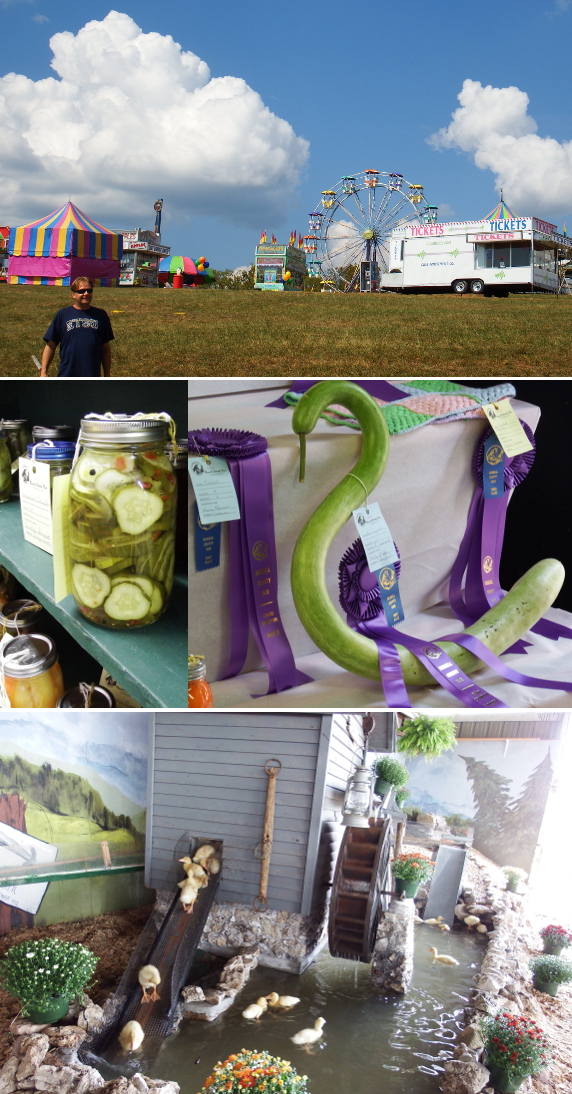
I wonder how different
county fairs were two hundred years ago. Were random passersby like me
left wondering how they judged the hay and decided that
bale was better than this one --- did they put it to the goat test? Did
folks walking through the barnyard exhibit wish that the goats had
instead been on leashes walking through the crowd the way they obviously
ought
to be? Did milkmaids never get to ride the ferris wheel because the
carnival portion of the fair doesn't open until after supper, awfully
close to milking time?
Or perhaps I'm just a little too obsessed with goats....
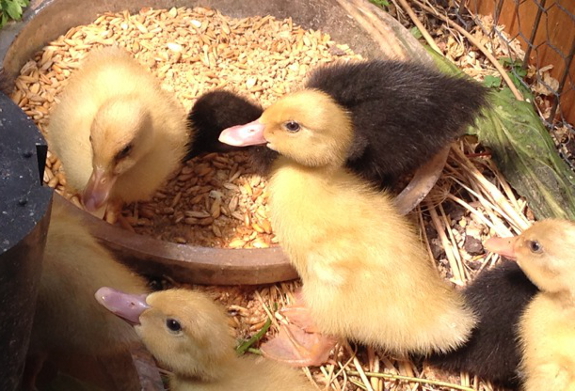
My two female ducks (no
specific breed, barnyard duck . . . may have some runner) started
setting; the second time this season. This past spring every single egg
they set on was infertile. When they became broody again, I researched
the Muscovy drake/’normal’ duck breed cross a bit more. I learned that
in natural breeding settings, these only have a 20-30% fertility rate.
No wonder the spring eggs were all infertile! I ordered a dozen
ducklings from a hatchery, for delivery the week the broody ducks would
be hatching, if any of their eggs were fertile. I had grand plans of
foster ducklings and happy foster mother ducks.
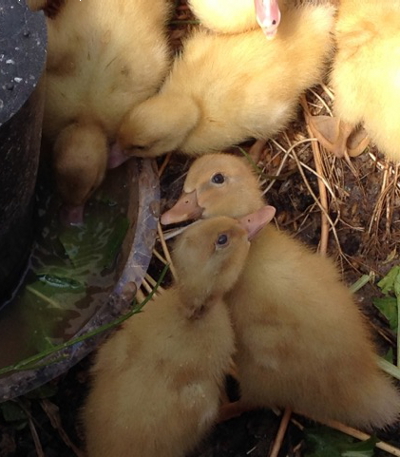 The
ducklings hatched August 31st and arrived at the local post office
September 2nd. No foster duck success. What to do with all of this
cuteness? I sort of forgot that I am off-grid!
The
ducklings hatched August 31st and arrived at the local post office
September 2nd. No foster duck success. What to do with all of this
cuteness? I sort of forgot that I am off-grid!
Looking around, I have a
greenhouse (although the sides are rolled up for summer), an old very
small charcoal kettle grill, two bags of lump charcoal (leftover from
making a charcoal walled evaporative coolbox which I use to keep food
cooler on the hottest summer days), and a top of tank propane heater
(normally used in the winter in my covered, but by no means enclosed
propane camp shower.) I have 600Ah of battery capacity and 790W solar. I
use about 60Ah/day for my normal living (~10% of my battery power.) I
have the idea for charcoal heat from travel in Africa, where I’ve seen
small-scale poultry producers use charcoal heaters for brooding. The
ones they use last about 8 hours before needing refilling, per
conversations with the producers.
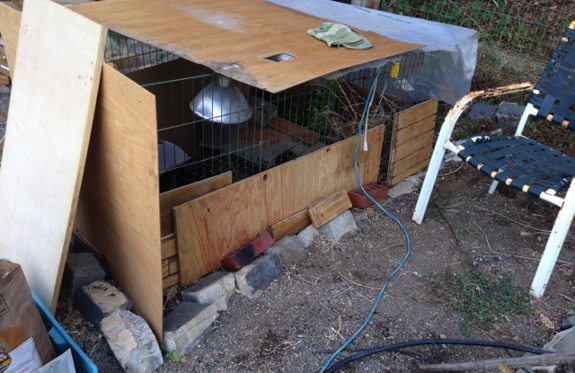
I set the ducklings up in a
pen directly on a bed in the greenhouse. I placed small bits of plywood
and cardboard all around the pen to limit drafts. Storey’s Guide to Raising Ducks mentions that in mild weather, a low insulated area can be used by the ducklings to keep warm utilizing their own body heat.
I used remnants of 2x4’s for sides, against a cardboard draft guard as
the back, and open on the front. It is only 3 2x4’s high, so about 5
inches high. I cut 4 pieces of cardboard to layer on top, as insulation.
It is dark and I’ve had to herd the ducklings in a few times, so they
can get used to it. 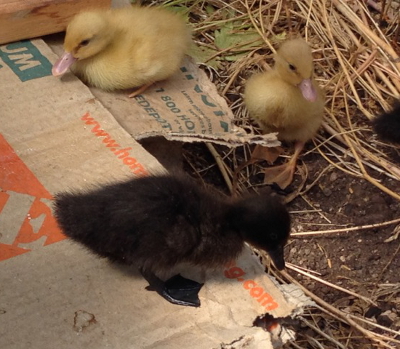 They
actually haven’t really used it at all. That is meant to be a place to
get warm during the day, when the sun goes behind the clouds. They have
enjoyed climbing on top of it though. So far the ducklings haven’t shown
any real signs of being chilly during the main part of the day between
the draft guards and the protection and extra warmth of the greenhouse.
They
actually haven’t really used it at all. That is meant to be a place to
get warm during the day, when the sun goes behind the clouds. They have
enjoyed climbing on top of it though. So far the ducklings haven’t shown
any real signs of being chilly during the main part of the day between
the draft guards and the protection and extra warmth of the greenhouse.
My principal heat has been
the charcoal kettle grill and charcoal starter. I set up four bricks
(flat – 2 bricks high.) They have a brick’s worth of space between the
two stacks. This is the base. I set the small kettle grill on top of
that (my little grill is very old and doesn’t have legs – the grill body
goes directly on the bricks) and then start a full charcoal starter set
inside. When I dumped the lit charcoal into the kettle, as if I were
going to barbeque, it did heat the entire base 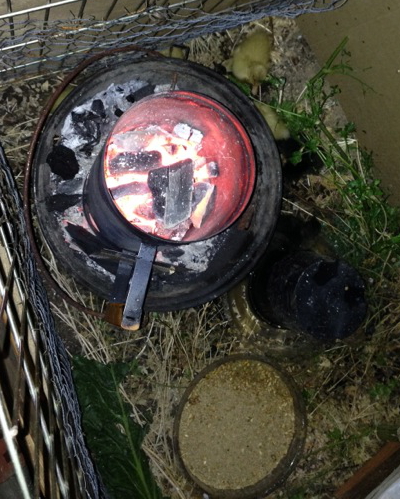 well,
but the charcoal also burned out relatively quickly. If I leave the
charcoal in the charcoal starter, and set the lid of the kettle grill
perched on top, it will last ~3 hours and puts out a lot of heat. I
start it about 6pm and then refresh the charcoal at 9pm, 12pm, 3am, and
6am. It takes not quite one 8.8lb bag of charcoal for that period.
well,
but the charcoal also burned out relatively quickly. If I leave the
charcoal in the charcoal starter, and set the lid of the kettle grill
perched on top, it will last ~3 hours and puts out a lot of heat. I
start it about 6pm and then refresh the charcoal at 9pm, 12pm, 3am, and
6am. It takes not quite one 8.8lb bag of charcoal for that period.
I’ve borrowed a standard
heatlamp from my neighbors. I use that for my shoulder periods. It warms
up immediately and I have it hanging ready to plug in. It uses about
30amps/hour, or about 5% of my battery bank/hour. That is A LOT of
power. My solar system can’t handle that all the time, but for a couple
of hours a day it is a good backup – when the charcoal finishes in the
morning, if the sun isn’t fully up, or if the greenhouse gets shaded,
while I’m starting up some charcoal.
I haven’t yet used my top of
tank propane heater (my plan C). I’m mostly concerned about risk of
fire. If I had been planning ahead and ready to brood ducklings (instead
of coming up with solutions on the fly), I would likely want to try a
small propane hog farrower such as Gasolec makes. For now, I’m very
happy with the heat the charcoal is giving, and the fact the ducks
appear to be sufficiently warm during the day without extra heat due to
the greenhouse.
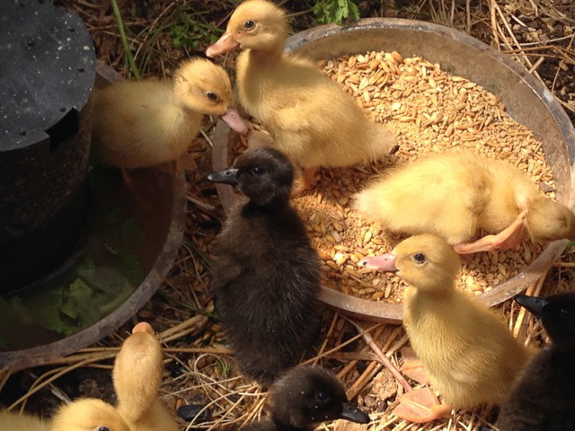
The ducklings go under the
kettle grill and between the bricks when charcoal is burning in the
charcoal starter, set within the grill. It is very easy to light and
heats up fairly quickly. I am sleeping within the greenhouse (the
weather is quite beautiful and I want to be near, in case the ducklings
need me while I’m working out the kinks). I set my alarm for about 3
hours. At times, there are still a few coals, and I only need to add
more charcoal. Often the charcoal is out though. The ducklings are still
doing well though and there is significant heat built up in the bricks
the grill is setting on to tide them over until I get more charcoal
going. I would like to get to up the 8 hours that my off-grid
compatriots in Africa get. I’m going to try to rig a longer charcoal
starter type of tool from 6” stove pipe.
I was worried that the
ducklings might burn themselves on the charcoal kettle grill. They are
walking underneath it and cuddling next to it (but it is just above
them.) They could easily reach it, if they were interested. No one has
singed themselves yet! I will likely need to raise it up another two
bricks, as they grow.
I would love to hear other experiences with off-grid, non-traditional
brooding. I didn’t really plan on brooding these babies, but my master
foster mother plan was a complete fail. Now that I’m figuring it out, I
might do it on purpose with meat birds in the spring. (My ducklings are
Cayuga, the little black ones, and Buff; all from Metzer Hatchery.)
Charity Hanif homesteads in the paradise of the Oregon Coast, between international economic development visits to Africa.
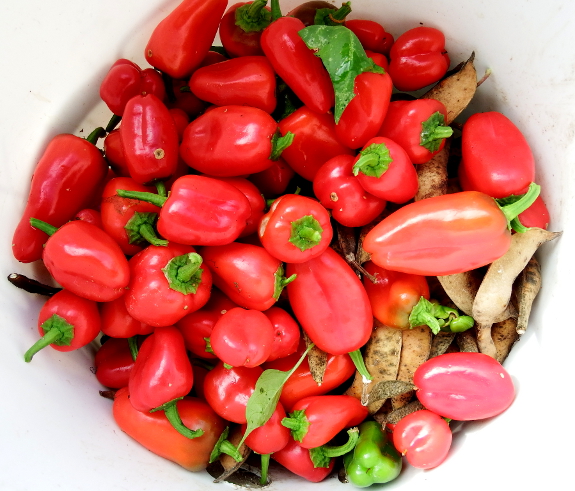
A cool August slowed down a lot of heat-lovers, like the sweet peppers shown above. But they're starting to roll in now, better late than never! Last year, I chopped our sweet peppers 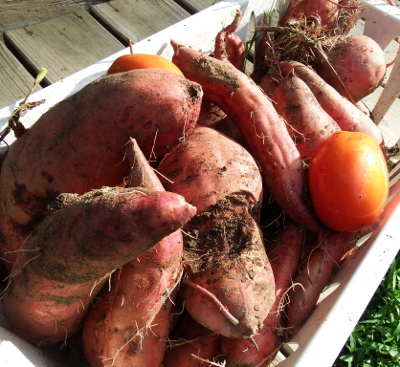 into
small pieces and froze them in ziplock bags, which made for easy
seasoning-dashes in winter dishes. I'm glad to be able to repeat the
preservation trick this year. One pint down, as many as we can fit in
before the frost still to go!
into
small pieces and froze them in ziplock bags, which made for easy
seasoning-dashes in winter dishes. I'm glad to be able to repeat the
preservation trick this year. One pint down, as many as we can fit in
before the frost still to go!
I'm also starting to
harvest our sweet potatoes so they'll have plenty of time to cure before
cold weather hits. I'd planned to only dig a few hills per day,
figuring their vines would be enjoyed by the goats. But our spoiled
ladies turned up their noses even after I told them how much deer adore
sweet-potato tops. I guess I'll go ahead and harvest the rest of the
planting today before whoever's been nibbling on the tubers does much
more damage.
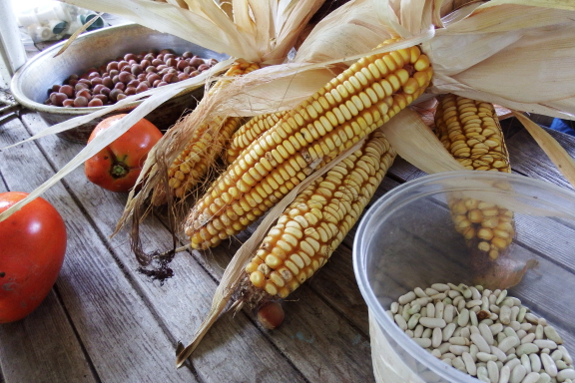
Meanwhile, our porch
dining table has been halfway taken over by my seed-saving station.
Since I'm a far-too-speedy eater, I like having a stockpile of beans to
shell or hazelnuts to husk to keep my hands busy while Mark finishes his
meals at a more normal pace. Last week, I was shelling beans for
planting from our Masai bushes, and this week I harvested another half gallon or so of scarlet runner bean pods from our shade vines, along with the last of the year's mung bean
pods, both for eating. The field corn is being husked too since I
learned the hard way that, even on drying racks, corn in the husk will
mold instead of dry in our humid climate.
I didn't bother to take
photos, but I also harvested another twenty
pounds or so of butternuts, bringing our total 2015 yield up to about
225 pounds. Add in a batch of mozzarella plus a pot of soup over the
weekend and it's been a pretty productive week already. But we've still
got basil and okra and green beans and sweet
corn to preserve in the days to come.
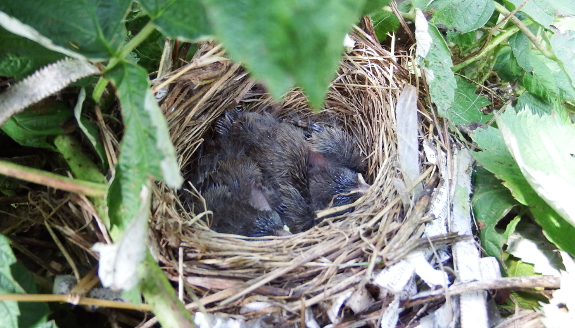
Since I ended last week's harvest update
with a Song Sparrow photo, I thought I'd snap a shot this week too.
What a difference eight days make! I have a feeling these chickies will
have left the nest and learned to fly before I regale you with a harvest
post once again.
Our goats got out today.
Luckily Anna spotted them
before they could munch too many apple leaves.
The solution was to upgrade
to the best
heavy duty gate latch.
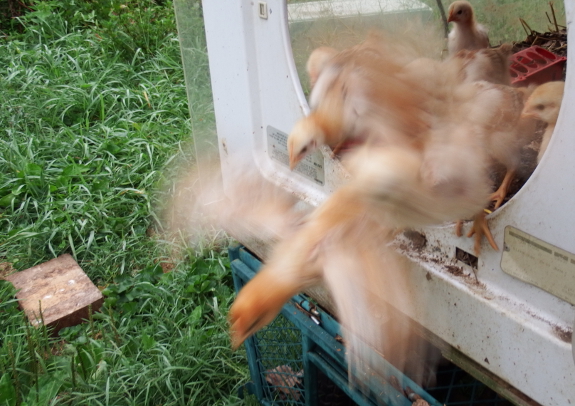
This is going to be a
disjointed post because this is a disjointed time of year. I tend to
have ten items on my morning to-do list each day, which keeps me
stimulated and the homestead healthy. It doesn't make for a very
cohesive story, though.
First item of the morning
--- letting out the chicks and doing a head count. They have a ramp to
get up into their brooder, but I have to let the board down to close the
door. And the chicks are always in such a hurry for a sip of water that
they fly out without waiting for the easy route.
But their excitement also makes it relatively easy to count heads since
there's a bottle neck at the brooder exit. Good news today! No new hawk attacks
since we moved the brooder to the new location and startled the raptor
in action twice in one afternoon. I guess being outside the back door is
just as good as building the chicks an enclosed play area.
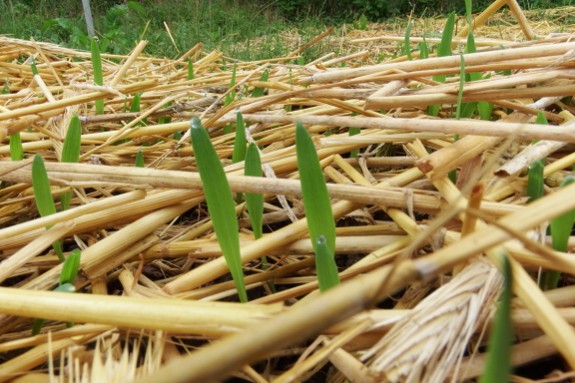
In the garden, oats
are coming up here, there, and everywhere. For the first time, I made
my way through an entire fifty-pound bag before oat-planting season
ended. Since our goats adore this fall cover crop, Mark's going to get
me another bag, and we'll see how much of it we can find room to plant
in the next week before the season shifts into rye time.
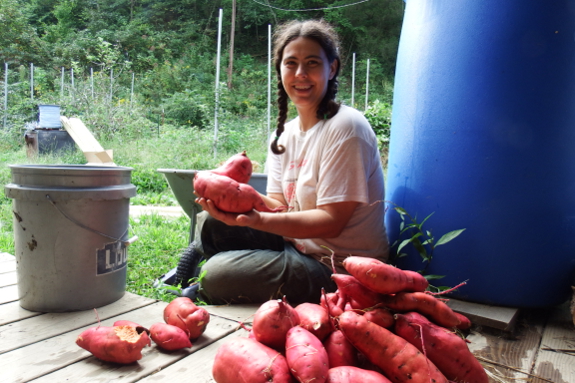
One new spot where I'll
be able to plant oats is in the sweet potato plots since the huge tubers
have been disinterred from their raised beds. The potato in my hand is
probably the largest one we've ever grown, clocking in just shy of three
pounds. The nibbled potatoes on the left will go to Abigail, who enjoys
the tubers even if she's not so keen on the vines.
Not pictured, I also
planted another round of fall lettuce along with a couple of beds of
mustard. Here's hoping the forecast rain soaks the ground and gets these
leafy greens growing to join the kale and arugula that are already
making their way into our kitchen.
A busy morning! Time for lunch.

I might have gone a
little overboard on our second-to-last sweet-corn planting this year.
Some of the earlier plantings consisted of old seed that didn't sprout well, so I filled in a pretty big  area when the new seed came in the mail. But now I'm stuffing bags of sweet corn in every nook and cranny of our larger chest freezer, trying to decide if we need to plug in the smaller spillover freezer just for the sake of corn.
area when the new seed came in the mail. But now I'm stuffing bags of sweet corn in every nook and cranny of our larger chest freezer, trying to decide if we need to plug in the smaller spillover freezer just for the sake of corn.
In the end, I froze five
quarts of corn Thursday and I have nearly as many left to go before this
planting is fully processed. The big question is --- will our final
planting have time to mature, or will this weekend's forecast low of 44
turn into a first freeze nearly a month earlier than usual? (Yes, our
lows are often at least 10 degrees below the forecast.)

I really know better than letting 2.5-week-old chicks out of their brooder on a rainy day. But our Red Rangers are so industrious, and they run back into the brooder every night on their own, so I figured they were smart enough to come in out of the rain.
Wrong! Instead, when drops started to fall, the chicks holed up
underneath the brooder. That worked okay until water started splashing
in and the fluffballs got chilled. At which point I rushed out in the
wet to try to herd them up into the dry.
 This
operation would have gone more smoothly had Mark been home. But he was
away at school, which reduces my chicken-herding abilities by about
1,000%.
This
operation would have gone more smoothly had Mark been home. But he was
away at school, which reduces my chicken-herding abilities by about
1,000%.
So I chased the boys out from under the brooder...and they took cover
beneath a bush. Then I chased them away from the bush, at which point
half ran up the ramp and the other half ran back under the brooder. In
the end, I was stuck capturing the less domesticated chicks one by one
on my hands and knees on the wet grass.
Looking at this after
picture, I realize that the chicks really weren't all that damp anyway.
And since the rain stopped an hour later, I might have gotten away with
leaving them alone.
Instead, I'm the one who got soaked to the bone. Good thing my
thermoregulation skills are vastly superior to those of half-feathered
chicks, so we all dried off with no ill effects.
Our trusty bungee
cargo net helped to increase garbage hauling by 20 percent.
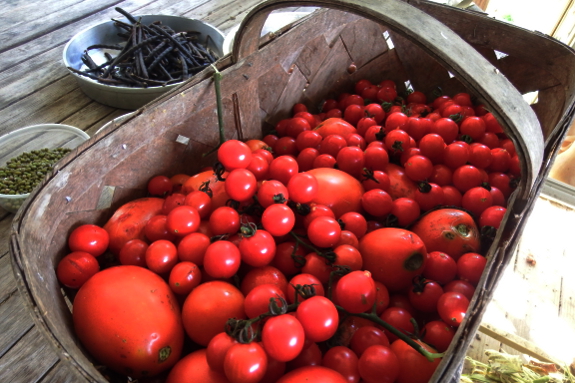
There comes a time in the
life of every garden when the head gardener is just so overloaded with
produce that she has to make tough decisions. The tomatoes --- yes,
we'll preserve every ounce of those. But maybe that huge basket of okra
and sweet corn would be better off visiting another household?
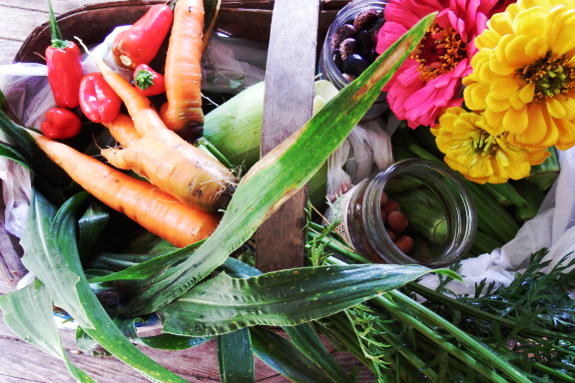
I figured if I sweetened
the pot with some fresh carrots and peppers and hazelnuts and scarlet
runner beans and zinnias, Mom wouldn't realize I was just trying to
foist off my unwanted children on her.
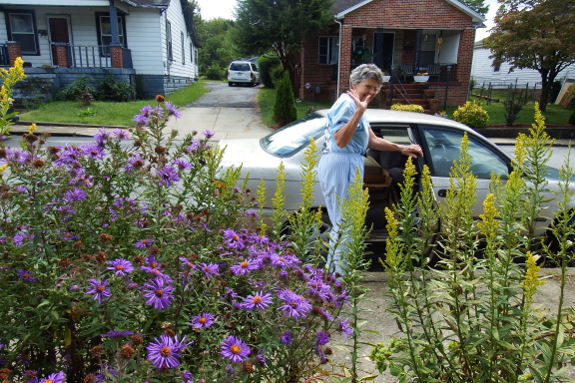
In exchange, my kind
mother filled the back seat of our car with found cardboard. One man's
trash is definitely this woman's treasure! Thanks, Mom! Seems like a pretty fair trade.
Okra yields have been high this Fall.
Some of the plants are
getting close to being 7 feet tall.
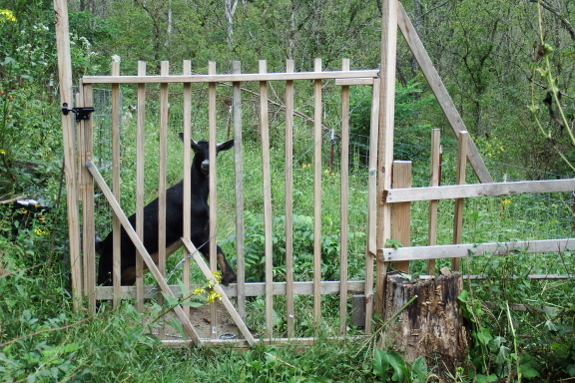
Sometimes I enjoy our
goats' company so much that I forget to write (or even think) about our
production goals. But I figured I owed you (and them) some goat geekery.
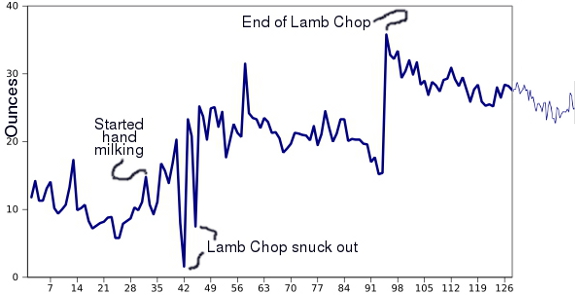
Six weeks ago, I shared Abigail's lactation chart to date.
I couldn't seem to find my original spreadsheet, so I used a lazy
approach to update it --- the thinner line shows her August and early
September milk production figures.
Although our current
average of a little less than three cups of milk per day is pretty
measly by high-class goat standards, I'm actually quite happy with
Abigail's perseverence and still have no plans to dry her off. However, I
am considering changing our doe over to once a day milking.
The downsides --- production will probably drop a bit more and the
chance of mastitis will increase slightly. The upsides --- I won't have
to feed Abigail as many concentrates since I won't have to keep her busy
during two milkings, I'll only have to clean milking equipment once per
day, and I won't have to be so careful about always being home at the
proper time in the evening. Experienced milkers --- feel free to share
your thoughts on this unconventional choice!
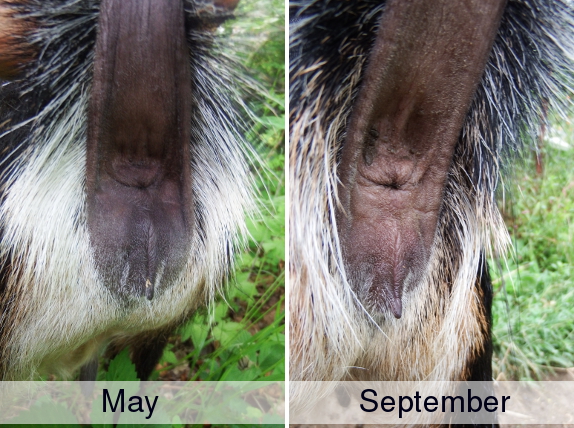
On another note, after talking it over with Mark, I realized that we don't really have
to breed both Artemesia and Abigail this fall. After all, milking one
goat is quite enough for my carpal tunnel and for our bellies, and our
farm isn't operating close enough to the poverty line that the resulting
lack of efficiency will be a problem. So we're focusing on getting
Artemesia knocked up this fall and giving Abigail a year of
companion-goat duty.
To that end, I've found
two potential suitors for our doeling's first date and have been
watching carefully for signs of heat...but seeing none. Suddenly I
started wondering if Lamb Chop could have done the job after all this spring. I still think that's unlikely, but I took some goat-butt photos
just to consider the possibility. Results: uncertain. I'll keep looking
for heats and chatting with buck owners in hope of getting our girl
pregnant in late October for a late March birth.
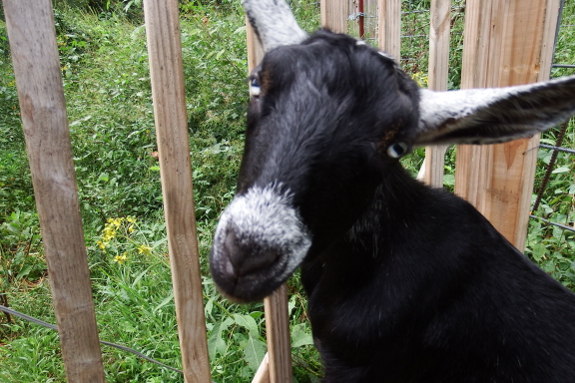
Okay, that's enough geekery. Back to your usual round of cute-goat photos in subsequent posts.
We converted our hallway closet into a butternut squash storage unit.
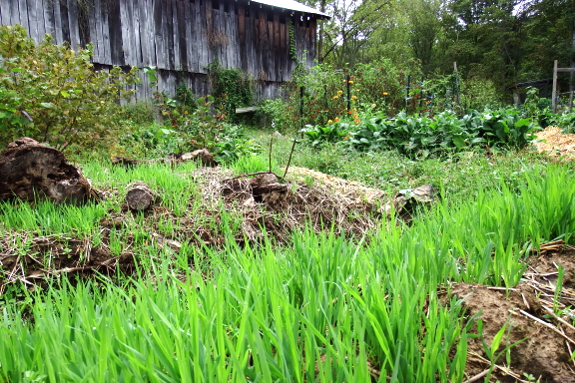
Mark spent $9 on another 25 pounds of oat seeds...because the first 50 pounds just weren't quite enough for me.
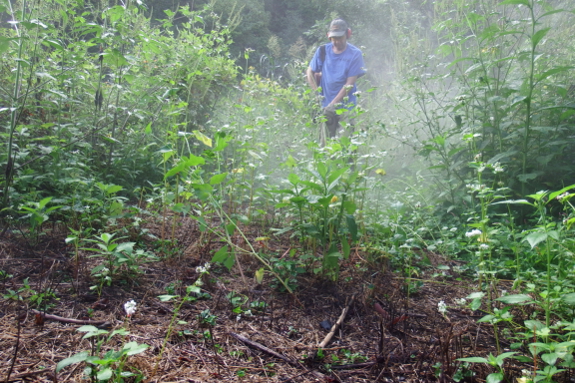
And then, long-suffering
husband that he is, he obliged me by weedeating some experimental beds
to use up the seeds I couldn't find room for in the garden. This patch
was pure weeds this spring, then I solarized
it for a month or so in the summer. As you can see, partial-shade
conditions and the power of perennial weeds meant that some plants
sprang back up from the roots despite the cooking time. I'm hopeful that
scattering oat seeds and weedeating to the ground just before a rain
will mean the cover crops sprout and make a goat-fodder patch. Then
perhaps we can fold this area into garden production next year. Or,
worst-case scenario, we just wasted a buck of oat seeds and will have to
start from scratch here if the experiment fails.
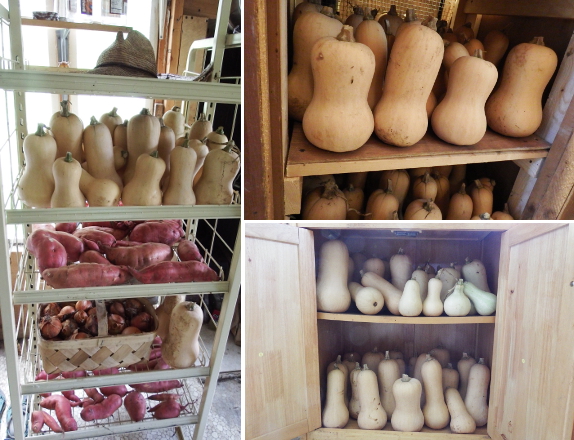
Just in case, we prepared
for a potential early freeze by bringing in all of our storage
vegetables off the porch. Some were ready to enter their final storage
locations, while others need another couple of weeks curing on the rack.
(And, since someone asked last week and I forgot to reply to their
comment --- if you're curious about how to cure and store vegetables
that don't require fancy preservation, you can read everything I know in
Weekend Homesteader: October.)
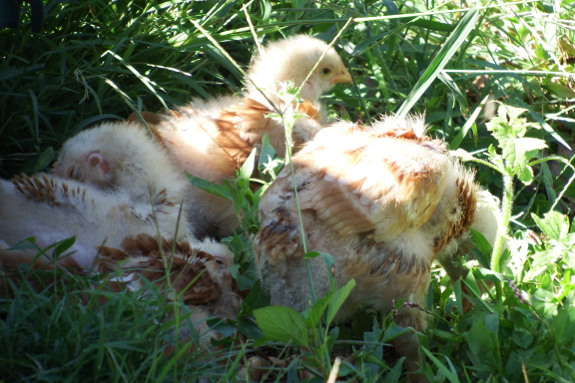
Next we covered up our
pepper plants (the only summer crop that hasn't already reached quota in
the preservation department) and settled in to wait for the Monday low.
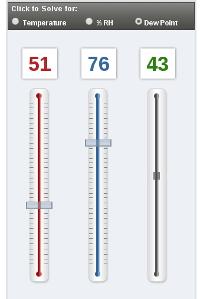 Okay,
I lied. I can't wait worth a darn, so I instead finally researched a
topic I'd read a little bit about but never really delved into --- the
dewpoint temperature. The idea is that gaseous water starts turning
liquid at a certain temperature, and in the process a lot of heat is
released. That release of heat makes it very difficult for
moisture-laden air to drop below the dewpoint temperature. So unless a
cold front is blowing in, you can guess the night's minimum temperature
by using temperature and humidity at sunset to calculate the dewpoint. Here's a website that does the math for you.
Okay,
I lied. I can't wait worth a darn, so I instead finally researched a
topic I'd read a little bit about but never really delved into --- the
dewpoint temperature. The idea is that gaseous water starts turning
liquid at a certain temperature, and in the process a lot of heat is
released. That release of heat makes it very difficult for
moisture-laden air to drop below the dewpoint temperature. So unless a
cold front is blowing in, you can guess the night's minimum temperature
by using temperature and humidity at sunset to calculate the dewpoint. Here's a website that does the math for you.
Did my calculations work?
Sunday night, it was 51 degrees with 76% humidity...and Monday at dawn
it was 43 degrees outside. Exactly as estimated!
Of course, Tuesday was a
little bit different. My weather guru had explained that our valley
location means that the second day in a cold spell often attains lower
temperatures than the official forecast. I can't recall his exact
reasoning, but I think the deal is that the cold air from the previous
day gathers in the mountains above us then flows down into our valley
that second night. Sure enough, the second day of our cold spell saw
temperatures a few degrees lower than our dewpoint estimate...but still
above freezing. Phew!
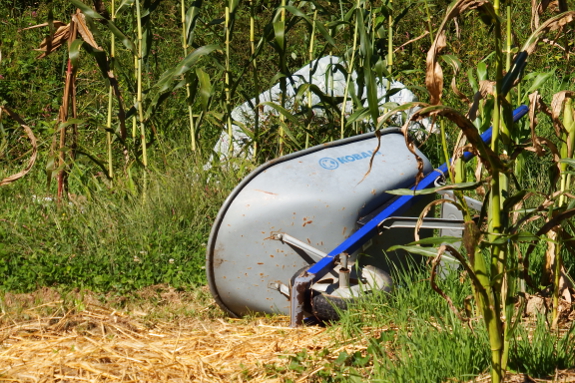
Okay, I say I'm
relieved...but I'm actually just about ready for the gardening season to
wind down. But it's worth a bit more pushing at this time of year to
grow organic matter rather than weeds in fallow garden beds. So my tired
wheelbarrow will get back to work for a few more weeks, and then we'll
both enjoy our much deserved winter rest.
This is the first year we're
using Christmas lights as a supplemental
chicken light.
We're about a month behind
schedule in getting this started.
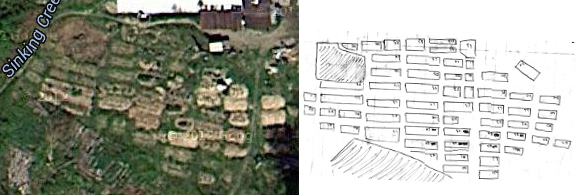
Our front garden used to
be my favorite growing spot. It began with B+ soil, while the rest of
our core homestead was closer to a D. But, over time, I improved the
soil everywhere else...which allowed the front garden's inherent flaws
to shine through. First of all, there's the wacky layout, with lots of
little beds dug before I knew any better. Then there's the fact that
this area turns into permafrost in the winter and even in the summer
only the very center of the front garden counts as full sun. Which is
all a long way of saying --- the front garden is now my least favorite
gardening spot, so it tends to get neglected. Time for a hard reboot!
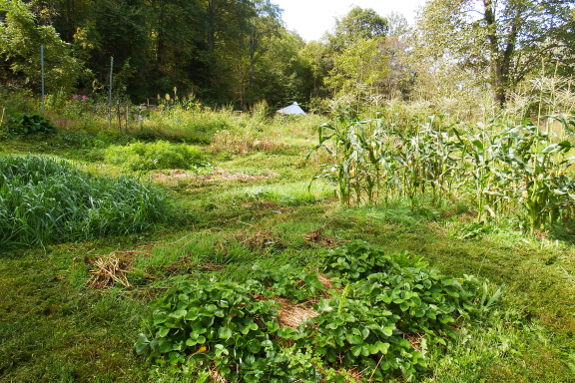
First step --- a close
mow of the aisles so we can see what we're working with. Next step ---
trick Kayla into coming over to help me move dirt. Here's hoping she
doesn't read this post before she heads out the door or she might just
call in sick....
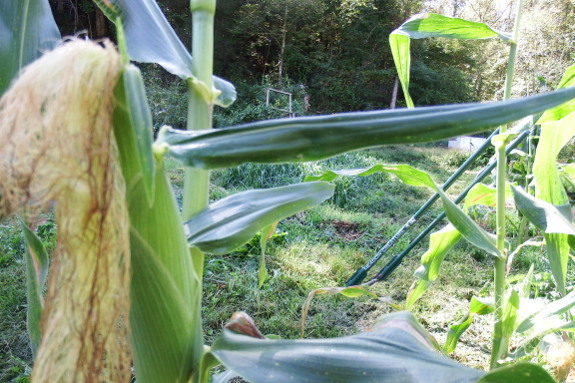
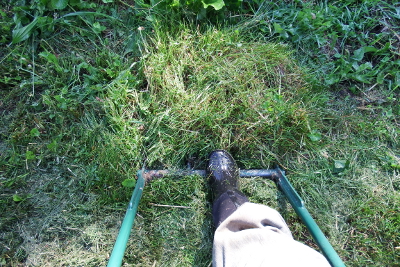 The first step in my front-garden renovation involved
de-compacting the cross aisles. I've tried to simply kill mulch these
spots in the past and then plant into the bare ground. But after being
walked on for nearly a decade, the soil is too compacted to turn
directly into vegetable-garden soil the quick and easy way. So I pulled
out the broadfork and gave a few of the cross-aisles some much-needed aeration.
The first step in my front-garden renovation involved
de-compacting the cross aisles. I've tried to simply kill mulch these
spots in the past and then plant into the bare ground. But after being
walked on for nearly a decade, the soil is too compacted to turn
directly into vegetable-garden soil the quick and easy way. So I pulled
out the broadfork and gave a few of the cross-aisles some much-needed aeration.
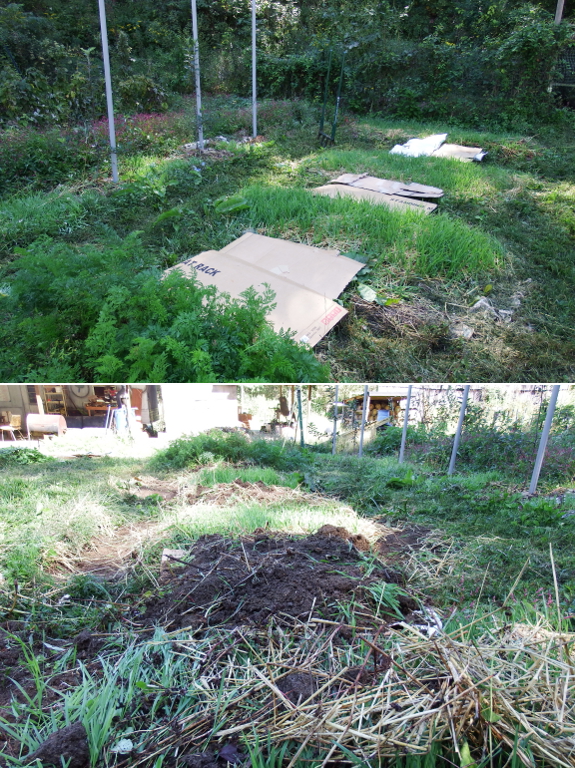
The other reason simply
kill mulching cross aisles failed for me is because I'd already shoveled
all of the topsoil out of those areas to apply to the garden beds. So,
after laying down a layer of cardboard to block the weeds, I remedied
that problem by bringing soil from garden areas I was deleting and
applying it to the cross aisles. The photos above show four small beds
that were merged into one long bed running the other direction to
expedite mowing --- it really is much simpler if all of your beds are
parallel to each other. This area is a bit too shady for vegetable
gardening, so I'll plant some high-density apples here and hope they get
enough sun to thrive.
Much more garden renovation is still to come. Stay tuned!
We added another layer of
tarp protection to our mountain
of hay.
Another thing we did was to
block off the 2x4 she was using as a step.
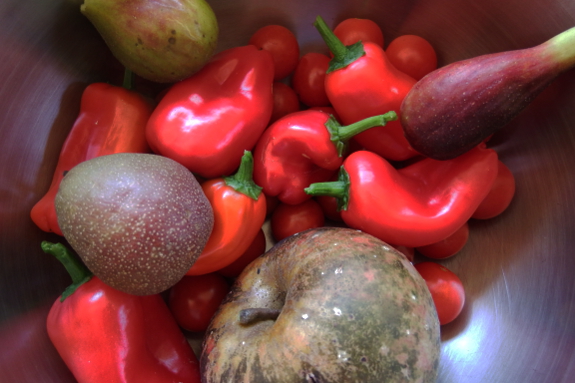
The harvest frenzy
is finally starting to wind down. We've been using the extra time to
kill off our old chickens and ducks and start getting the garden in
order for the winter. I'm sure you won't be surprised to learn that I'm
still adding more items to our to-do list every day than I remove,
though.
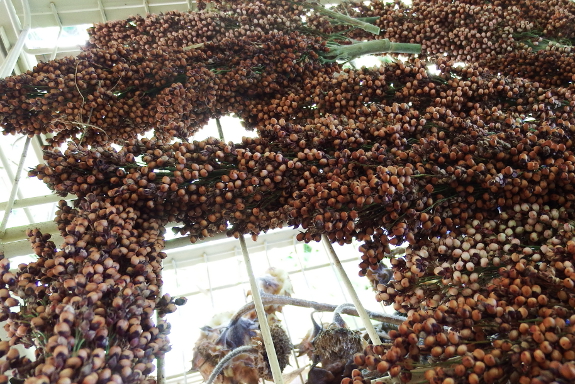
The only relatively large
harvest we made this week was sorghum. I'm mostly just playing around
with grains at the moment, but have to admit that sorghum is a keeper.
The heads are easy to cut free, they dry on our curing racks without
molding, and then the goats eat the seeds right off the stems during the
winter when I think they deserve a special treat. In the meantime, the
sorghum stalks (well, leaves really) are superior even to sweet-corn
stalks as morning goat fodder. Finally, our sorghum grew better than our
field corn in the waterlogged, clayey soil where I stuck it, figuring
an experimental crop didn't deserve better. I think next year we'll
delete the field corn and stick to sorghum as our primary goat grain.
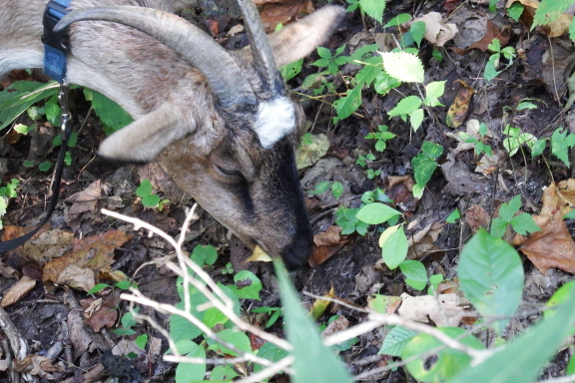
Abigail likes to eat the new leaves that have freshly fallen to the ground.
 Robert Kourik recently sent me a review copy of his newest book, Understanding Roots,
and I highly recommend it...for about 30% of our readers. Those of you
who love my geekiest posts, who aren't afraid of numbers, and who are
willing to read critically (Jake, I'm looking at you) will find Understanding Roots
both intriguing and thought-provoking. On the other hand, readers who
come here for the pretty pictures and whose eyes glaze over when I start
rambling on at length should probably skip this one.
Robert Kourik recently sent me a review copy of his newest book, Understanding Roots,
and I highly recommend it...for about 30% of our readers. Those of you
who love my geekiest posts, who aren't afraid of numbers, and who are
willing to read critically (Jake, I'm looking at you) will find Understanding Roots
both intriguing and thought-provoking. On the other hand, readers who
come here for the pretty pictures and whose eyes glaze over when I start
rambling on at length should probably skip this one.
If you've read some of Kourik's other books,
you'll know that the author has an intellectual crush on Dr. John
Weaver, who spent his entire career excavating soil to draw meticulous
maps of plants' roots in Nebraska. While Understanding Roots does
include many additional Weaver root maps, though, Kourik delved a
little deeper this time around and included drawings from other sources
as well. This is handy since the German scientists he tracked down, for
example, generally found much shallower roots for the same species of
plants compared to those Weaver drew. This shouldn't be entirely
surprising --- the deep soil of the Great Plains makes it much easier
for roots to delve deep, so those of us with poorer soil will likely be
dealing with considerably shallower roots than those shown in Kourik's
previous books.
Another intriguing point from Understanding Roots pertains to dynamic accumulators.
We've all heard the stories --- comfrey roots extend many feet into the
ground and suck up leached nutrients, which they return to the soil
surface for the use of other plants. But how true are the stories? 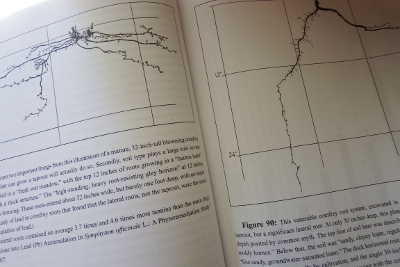 Kourik
assessed the data and discovered that most dynamic accumulators merely
concentrate nutrients from the topsoil, using deep roots (if present) to
search for water during droughts. In fact, the vast majority of comfrey
roots are found in the top foot of soil just like the roots of most
other plants. This is where the nutrients are highest, oxygen is most
plentiful, and beneficial microorganisms proliferate.
Kourik
assessed the data and discovered that most dynamic accumulators merely
concentrate nutrients from the topsoil, using deep roots (if present) to
search for water during droughts. In fact, the vast majority of comfrey
roots are found in the top foot of soil just like the roots of most
other plants. This is where the nutrients are highest, oxygen is most
plentiful, and beneficial microorganisms proliferate.
In the end, Kourik's book
is bountifully illustrated and full of sound science. But it's
definitely a text for the thinking gardener to curl up with in front of
the wood stove during a long winter night rather than a how-to manual to
inspire you to dive into the summer garden. So pick up this book only
if you're looking for a thought-provoking text to help you reach the
next level as a permaculture gardener.
Trying to do something with goats wanting your attention is more difficult...... but they make up for it with the fun they add.
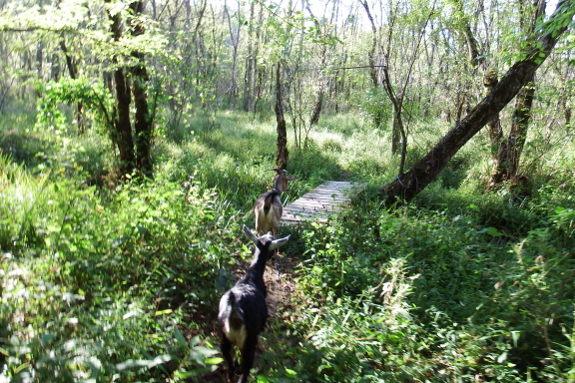
I decided to go for it and cut back to once-a-day milking. After all, the days are getting shorter all the time, and I'd really rather not end up milking in the dark.
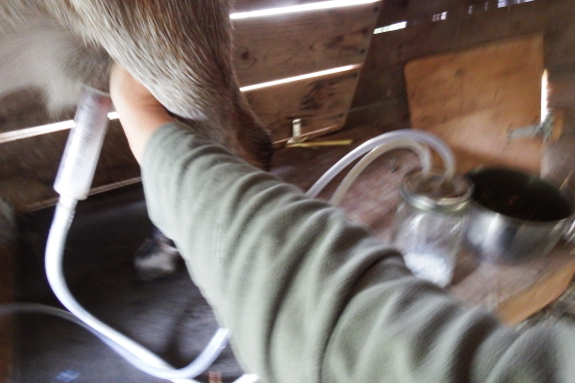
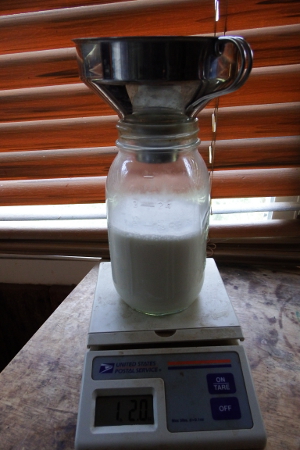 The first night, I felt so strange, not having a goat to milk. And production did drop, from 22.6 ounces per day to 18.3 ounces per day (a 19% reduction).
The first night, I felt so strange, not having a goat to milk. And production did drop, from 22.6 ounces per day to 18.3 ounces per day (a 19% reduction).
On the other hand, it
doesn't look like changing over to once-a-day milking is going to
increase the rate of decline. In other words, we're now getting a bit
more than a pint of milk per day, and the amount seems to be staying
pretty steady.
What about once-a-day
milking from the goat's point of view? Abigail doesn't actually seem to
mind. She's got plenty of room in her udder at this stage in the game,
and twenty-four hours of milk in September is less than twelve hours of
milk in May. So, no, she doesn't appear to be in any discomfort at all.
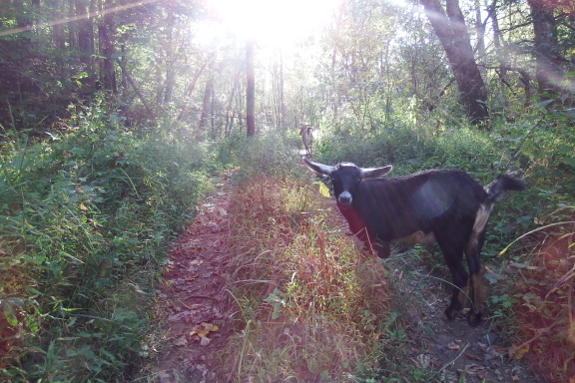
"Are we done talking about milk yet?" Artemesia asks. "Can't we go play?"
Yes, you're right, little goat. Skipping the evening milking does mean I have more time to watch you graze after supper. Let's go play!
Our Kale yield is above average this year and ready to be sweetened up by the future cold temperatures.
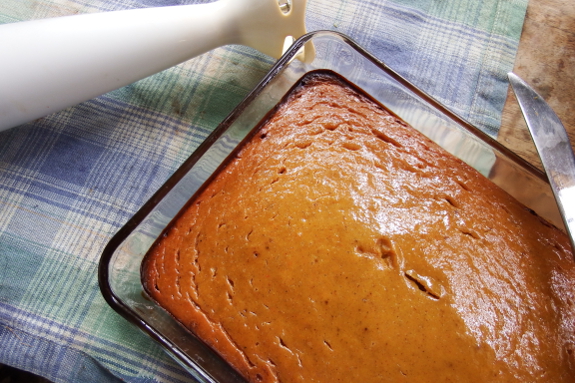
I've been really enjoying our immersion blender.
Not only does the tool allow me to cut up the skins of tomatoes in a
flash, it also purees the batter for a butternut pie extremely well.
This pie also marks our first taste of the new hybrid butternut variety Metro. The result? Delicious! Of course, it's hard to go wrong with a butternut pie.
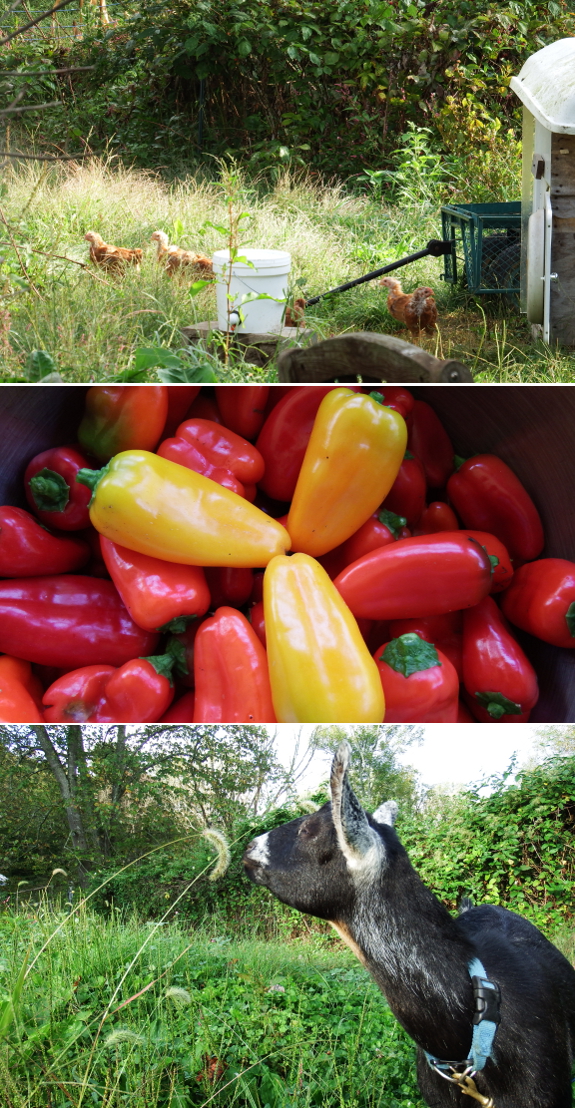
Soak up the sunlight
while you can --- solar luminosity is fading fast! And don't forget to
mark your calendars for a super lunar eclipse this coming Sunday. The
moon will begin to be blocked by the earth at 8:40 pm EST, with the full
blackout lasting from 10:11 pm to 11:23 pm. Since the moon will also be
at its closest approach to the earth during this particular eclipse,
the orb will appear 14% larger than usual. Here's hoping there are no
clouds to block the view!
Today we hauled and banked our first 135 gallons of horse manure for the year.
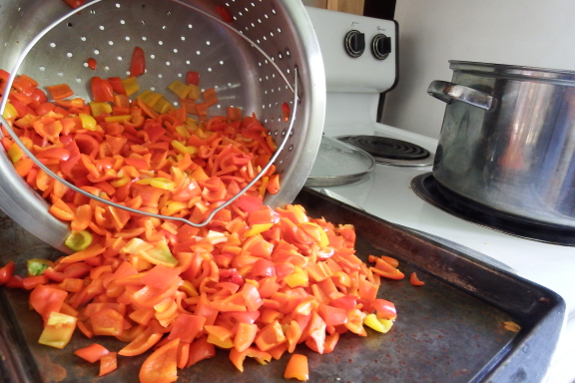
This is such a blissful
time of year. It's not too hot; it's not too cold. The huge summer
preservation push is mostly over (although I've still got a few things
left to pack away, like these peppers, recently blanched and fated for
the freezer); the fall crops are starting to come in. And even though
the garden needs some weeding still, I'm starting to feel like my work
is making a difference rather than just pacing along on the summer
treadmill.
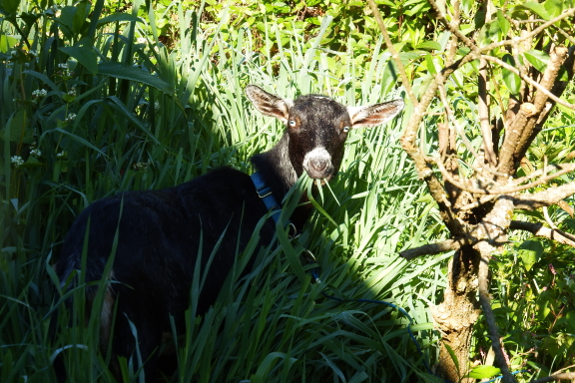
Meanwhile, the oats
I planted over the last six weeks are getting big enough that I'm
starting to let our goats eat the largest plants even though there's
still plenty of greenery elsewhere. The early feeding isn't really
spoiling our herd, nor is it being wasteful. Instead, I know from
experience that if I let this fall cover crop flower, the plants will
perish faster when the cold weather hits. By grazing the oldest
plantings now, our herd will set the cover crop back into vegetative
mode so the goats can graze the same ground once again after winter
comes knocking.
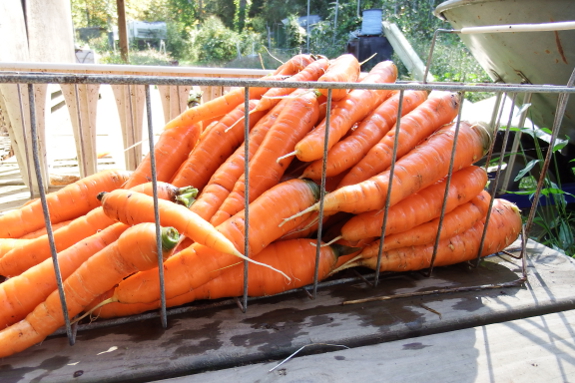
I owe you some photos of the front garden renovations
I'm still in the middle of, but you'll have to wait on those. Instead,
here are some of the carrots I harvested to clear out beds so I could
shovel dirt around and create one long row. I took the time to rinse off
each root so I could easily sort the imperfect goat carrots out of the
perfect human carrots. The picture above is the latter --- all straight
and spotless, perfect for winter cooking.
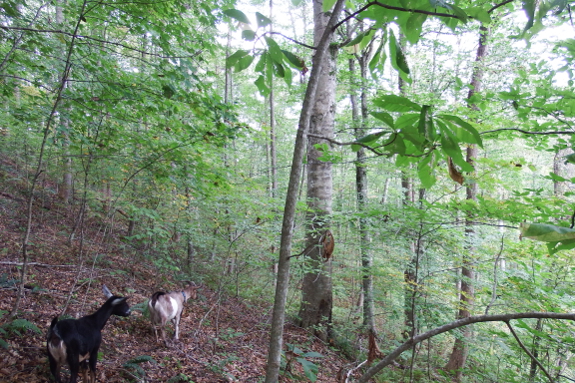
If I make it sound like
it's all work and no play around here...you'd know I was lying.
Sometimes, the goats suck me out into the woods two times a day instead
of just one, in fact. So maybe our hooved friends aren't the only farm
residents who are spoiled in late September.
 I promised you some photos of the next stage in my garden renovation project, so here they are! The first step was using the broadfork to loosen up aisle soil,
then laying down cardboard to create one long, wide raised bed (first
photo). Since I'm also widening the aisles, I was able to shovel topsoil
from beds that were being deleted onto the cardboard, which will
hopefully bring the whole area up to speed quickly.
I promised you some photos of the next stage in my garden renovation project, so here they are! The first step was using the broadfork to loosen up aisle soil,
then laying down cardboard to create one long, wide raised bed (first
photo). Since I'm also widening the aisles, I was able to shovel topsoil
from beds that were being deleted onto the cardboard, which will
hopefully bring the whole area up to speed quickly.
I'm scurrying a bit with
this project because it's garlic planting time, and these beds are
slated to be home to next year's crop. So, after building the first bed
(and a third of the next one --- you can see part of a new bed to the
right of the long, finished bed), I planted my garlic. Then I laid down a
two-sheet thickness of newspaper (second photo) between the cloves to
hold back any potential weeds coming up around our precious crop.
Atop the newspaper, I
added a sparse coating of chicken bedding (third photo), which consists
of straw, leaves, and manure scraped out of the chicken coop. Finally, I
topped that layer off with a deeper layer of fresh straw (final photo).
I'm a bit scared to put all of our eggs (garlic) in one basket (new
raised bed). The previous aisle areas, especially, are potentially
problematic since the garlic cloves there were planted right atop the
cardboard and won't have much soil to grow into until the kill layer and
the sod beneath decompose. But garlic is a shallow rooter and I plan to
water the entire planting in hard to get the decomposition process
moving along quickly. So I'm hoping I won't regret planting what I
consider our easiest crop in an experimental area.
(You may be curious why I only planted 75% of our crop during this first
garden spree. It's simple --- I ran out of cardboard and newspaper! I'm
going to have to stockpile a bit more of both before I can complete our
planting. Drat!)
We went 180 feet underground today in the beautiful Bristol Caverns.

As Mark mentioned, we started off our staycation with a visit to Bristol Caverns.
I grew up in Bristol and am pretty sure I went there once as a kid, but
the wonder of this mile-long cave system must not have fully sunken in
at that age. Returning as an adult, I was awestruck, and kept our poor
tour guide walking at a snail's pace for an hour and a half as I soaked
up the beauty...and took 108 photos.

It's hard to capture the
full effect of the massive open spaces and intricate formations with
still images. At times, I felt like I could barely breath because of the
sheer beauty around me...or perhaps I was breathing even deeper than
usual. The lighting was near perfect, highlighting features and drawing
the eye further into the cavern with every glance. In fact, I felt a bit
like I was walking through an art installation in the wild.

There were also
interesting historical tales, about Indian raids and about a more modern
human who stumbled across the cave entrance while building a root
cellar. And geological facts about how the cave formed and shifted. But I
have to admit I expended more of my energy tuning into the gurgle of
the underground stream and feeling cool air encircle me than doing my
usual mental notekeeping. We'll definitely have to go back, so maybe
next time I'll pay closer attention.
If you want to visit, I heartily recommend this attraction. Ticket price
is $15 per adult. School groups, I've been told, tend to tromp through
the cave on weekday mornings, and weekends and summers are also busier.
But if you pick an off time as we did, you may end up on your own private tour, able to travel entirely at your own pace.
Lucy has decided our Soy Bean experiment can double as a tasty dog treat.
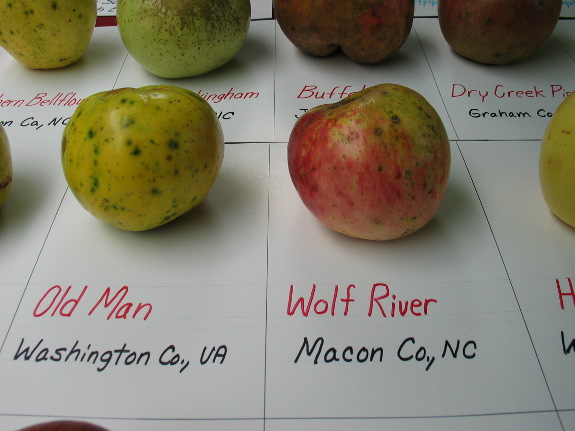 "My
wife and I just bought a piece of land out in central MA (zone 6A), and
I'm planning to put in a whole slew of fruit and nut trees next spring.
It's exciting, but also a daunting exercise trying to figure out what
to put in, how to arrange them, what spacing, etc. Do you have any
advice for a novice? Anything you wish you knew when you were planting
your first trees?"
"My
wife and I just bought a piece of land out in central MA (zone 6A), and
I'm planning to put in a whole slew of fruit and nut trees next spring.
It's exciting, but also a daunting exercise trying to figure out what
to put in, how to arrange them, what spacing, etc. Do you have any
advice for a novice? Anything you wish you knew when you were planting
your first trees?"
Starting a new food
forest is an exciting undertaking, although also fraught with a lot of
difficulties. What I wish I'd known before I planted the first tree is
that our initial site had such high deer pressure that nothing could
survive, then the second site had such high groundwater that winter
water once again killed all of my expensive trees, and finally that our
entire homestead exists in a frost pocket where spring blooms are
inevitably nipped by late frosts. Moral so you don't repeat my mistakes:
spend a year growing annual crops in your future food forest site to
find out which problems will need to be overcome before you throw a lot
of money away with perennials.
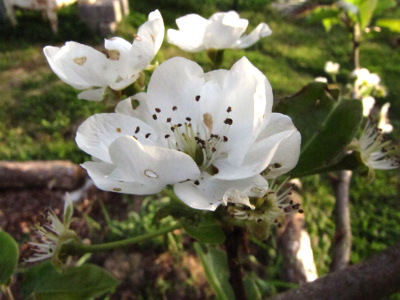 During
that year, you can learn grafting and can read up on forest gardening.
However, be aware that many of the authors of bestselling forest
gardening books are theorizers rather than practitioners with decades of
success under their belts. For example, I learned the hard way that planting comfrey within the root zones of young fruit trees results in nitrogen-starved trees,
despite the fact that many books advocate this type of interplanting.
And even though many texts list dozens of fruiting plants that can
handle heavy shade, scientific experiments suggest that yields are much reduced in these scenarios.
To be honest, I'm working my way out of wishing to create forest
gardening guilds and am focusing more on a diverse planting in which
each productive plant is given lots of mulched elbow room.
During
that year, you can learn grafting and can read up on forest gardening.
However, be aware that many of the authors of bestselling forest
gardening books are theorizers rather than practitioners with decades of
success under their belts. For example, I learned the hard way that planting comfrey within the root zones of young fruit trees results in nitrogen-starved trees,
despite the fact that many books advocate this type of interplanting.
And even though many texts list dozens of fruiting plants that can
handle heavy shade, scientific experiments suggest that yields are much reduced in these scenarios.
To be honest, I'm working my way out of wishing to create forest
gardening guilds and am focusing more on a diverse planting in which
each productive plant is given lots of mulched elbow room.
Since I'm keen on
no-spray organic gardening, I also wish I'd realized that many of the
commonly sold varieties will flounder in these conditions. Hunting down disease-resistant apples, pears, and stone fruits will reduce future headaches dramatically. While you're at it, high-density methods with dwarf trees
is a great way to get a head start on what will inevitably be a bit of a
game of trial and error figuring out which varieties thrive in your
unique conditions and suit your tastebuds. Of course, trees planted in
this manner require more work in the weeding, mulching, and
summer-pruning departments, but you'll cut years off your experiments
and will enjoy fruit much sooner. Once you figure out what grows well
for you, you can use that information to plant larger, less needy trees.
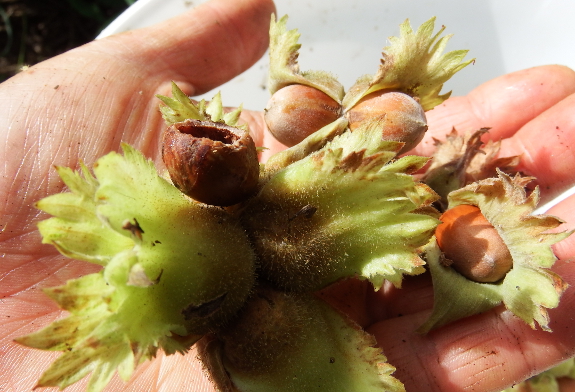 After almost a decade of experimentation, we're still very much getting our woody perennial legs under us. The only variety that has been an unabashed success has been the hybrid hazel
bush that started producing last year. It survived everything our farm
threw at it...so we planted three more bushes. Luckily, various types of
berries
have filled in the gap, but I'm still waiting for those bushels of
apples I dreamed about when we first moved to the farm. Maybe easily
coverable espaliers or that sunny hillside across the way will overcome
our spring freeze problems....
After almost a decade of experimentation, we're still very much getting our woody perennial legs under us. The only variety that has been an unabashed success has been the hybrid hazel
bush that started producing last year. It survived everything our farm
threw at it...so we planted three more bushes. Luckily, various types of
berries
have filled in the gap, but I'm still waiting for those bushels of
apples I dreamed about when we first moved to the farm. Maybe easily
coverable espaliers or that sunny hillside across the way will overcome
our spring freeze problems....
Jasper Red Cherry tomatoes
seem to want to produce to the very end.
Out of all the blight
resistant varieties we tried this year Jasper is the only one we'll
think about ordering again.
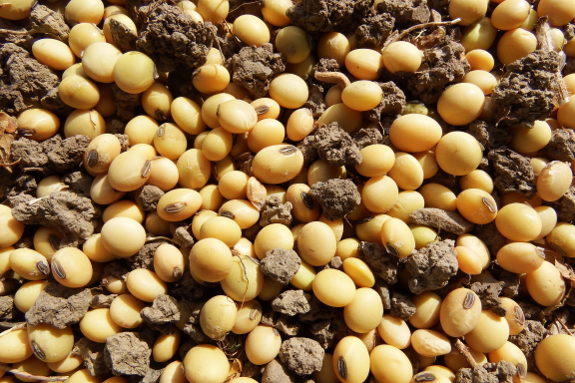
As Mark mentioned, we've
been harvesting some of our soybeans this fall. Since this is our first
year growing the crop (and since I'm primarily growing them for
soil-improvement purposes), my goal is pretty simple --- to end up with
as many seeds as I bought with minimal work. (Meaning I don't want to
shell the beans by hand and am willing to get much lower than maximum
yields as a result.)
But before I delve into my threshing experiments, I wanted to answer Susie's question
from this weekend. These are Viking 2265 soybeans from Johnny's, not an
heirloom but also not GMO. They're meant to be grown as a cover crop, but you could presumably eat the seeds. (Our dog and goats
sure like to.) If I lived in soybean country, though, I'd save my
pennies and buy the seeds at a feed store (although that source would be
much more likely to be GMO).
Okay, variety information
aside --- how did I separate my seeds from the plants and what would I
do differently next year? First, I yanked up plants once all the leaves
had fallen off and
piled the tops on a tarp on the porch. If I had this to do over again, I
would have cut the plants rather than yanked them --- the extra few
minutes at harvest would be worth it for the much lower dirt quotient in
the finished product. I also would have used a bigger tarp so the
plants could lie in one or two layers rather than in a mound since, even
though I harvested "dry" plants, some molded in the interior of the
pile due to our high humidity.
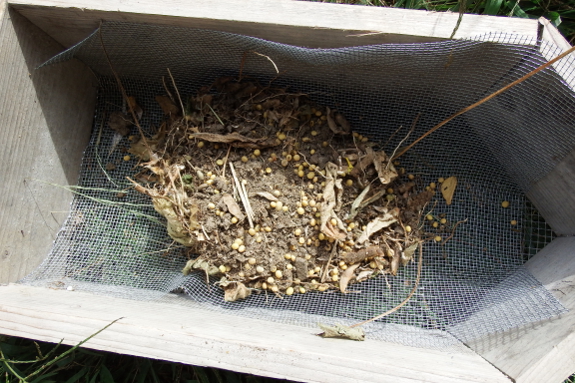
It took a week or two for
most of the soybean plants to start turning crinkly and dry. At that
point, I shod myself with close-toed shoes and did a little dance on top
of the plants as a rough-and-dirty threshing. Sure enough, quite a lot
of soybeans turned up on the tarp when I pulled the plants aside to peak
underneath.
I swept up soybeans, dirt, leaves, and all into a dust pan, then deposited the mass in my biochar sifter, retrofitted with a smaller screen that we'd bought for our honeybees.
I just pushed the new screen into the sifter on top of the old screen,
but it did its job --- preventing anything the size of a bean or larger
from falling through the holes. A bit of shaking, and the beans --- plus
dirt clods --- were separated from the smaller particles.
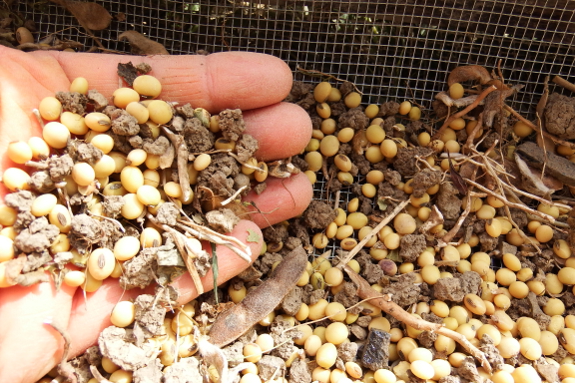
There are still quite a
few beans left in the plants on my tarp, so I'll do another round of
tromping and sifting once they dry a bit more. But I've already got
enough seeds for next year's planting, so I'll call the breaking even
part of this experiment a success. Looks like soybeans will be the first
of my cover crops that come full circle on the farm!
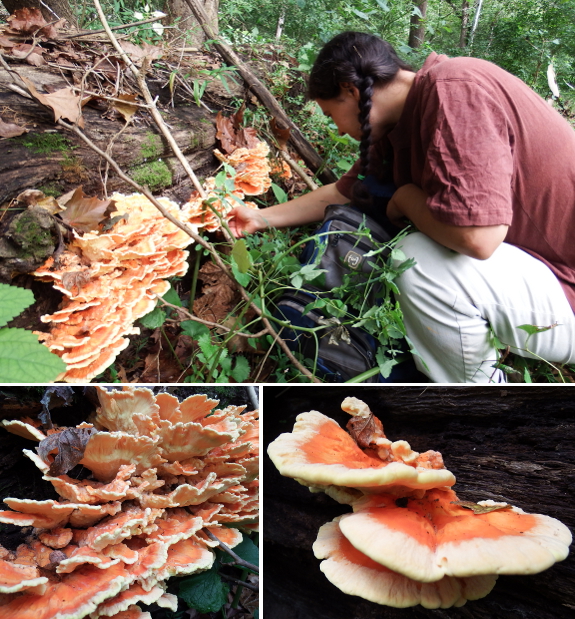
We went on a hike today and
found a huge log by the river with a large flush of Chicken
of the Woods mushrooms.

What's the recipe for a
perfect staycation? One part adventure, one part spending time with
friends and family, and one part relaxation. As with everything else,
the trick is finding just the right balance.
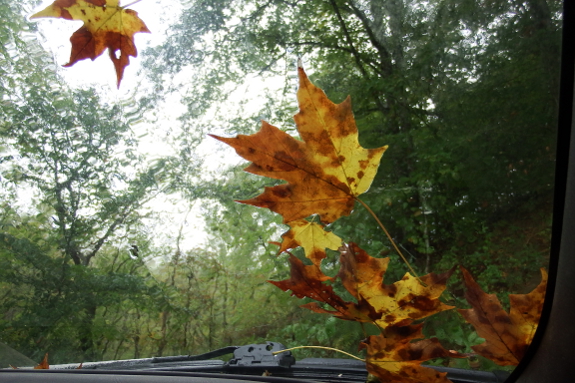
It's completely
un-homesteading related, but in case you're curious, my goal is to find
one interesting event for each day of our week off. To that end, we've
visited Bristol Caverns,
watched Star Wars episode 1 with Kayla and her husband (working toward
my goal of watching all six of the first movies in order before the next
comes out), missed the super eclipse due to clouds (oh well!), and had a
fun picnic in the park. Today, Mom's coming over, we'll probably head
to the movie theater to see The Martian later in the week, and I'm also
hoping I'll be brave enough to hike an 11.5 mile trail I've been eying.
And then we'll hit the
ground running with renewed vigor when our staycation is over. Already, I
can tell that it was a good decision to stay home this year. Ten days
of rest with minimal driving is just the ticket to make our homesteading
goals and projects come back into focus. And it's fun too!
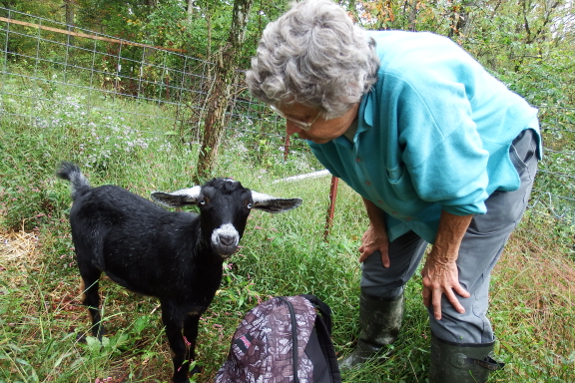
Our goat pastures are flattish and dryish, but otherwise contain some of our farm's worst soil. Seriously, nothing
but black locusts would grow there for the longest time. Even the
ground was nearly bare of herbaceous growth (aka grasses and weeds). So I
sent away a soil sample last fall, and the results confirmed my
suspicions --- this area needs help. The CEC was 7 and the pH was 5.2. No wonder plants kicked the bucket before they had time to get their feet under them.
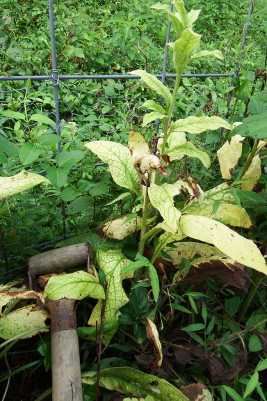 Now,
I'd planned to use the fast, traditional approach to solving my
acidic-soil problem --- adding lots of lime. But last winter was so wet I
would have had to carry dozens of 50-pound bags back to our core
homestead on my back. And our local feed stores suddenly only sold dolomitic limestone...which I don't want to apply because our soil is already overfull of magnesium. So I dropped the ball, ahem, decided to experiment with using ruminants to improve the soil.
Now,
I'd planned to use the fast, traditional approach to solving my
acidic-soil problem --- adding lots of lime. But last winter was so wet I
would have had to carry dozens of 50-pound bags back to our core
homestead on my back. And our local feed stores suddenly only sold dolomitic limestone...which I don't want to apply because our soil is already overfull of magnesium. So I dropped the ball, ahem, decided to experiment with using ruminants to improve the soil.
My experimental protocol
was simple --- use this pasture as a sacrifice area over the winter,
letting the goats poop there with wild abandon. Then, this summer, I
turned our herd of two into the same pasture at least a third of the
time, even when the does were clearly too spoiled to eat the grass and
weeds growing therein. In other words, I was taking hay from some other
farmer along with weeds and tree leaves from our own woods and gardens,
passing the plant matter through our goats' bellies, and using their
manure to fertilize the pasture's poor soil.
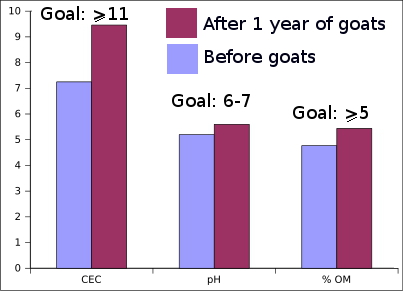 The
results were astonishing. CEC increased by 30%, percent organic matter
improved by 14%, and pH rose to 5.6. And plants also started to grow!
Not lush, thriving jungles of weeds the way we see in other parts of our
core homestead. But at least I stopped noticing comfrey so deficient in
nutrients its leaves were pale yellow.
The
results were astonishing. CEC increased by 30%, percent organic matter
improved by 14%, and pH rose to 5.6. And plants also started to grow!
Not lush, thriving jungles of weeds the way we see in other parts of our
core homestead. But at least I stopped noticing comfrey so deficient in
nutrients its leaves were pale yellow.
Meanwhile, calcium levels of the soil also rose, even though I applied no lime. If you're a proponent of remineralization,
you want 60 to 70% of the cation exchange sites in your soil to be full
of calcium. Pre-goats, our pasture soil was at a measly 33%; now the
calcium percentage is 42%.
Maybe in another two or three years, this soil will have been entirely
remineralized...all due to kelp-fed goats. Do you think then our darling
does will then deign to dine on their own grasses?
Our flock of future layers
have developed a bad habit of flying over fences.
It might be a side effect of
having multiple breeds in the same coop?
The solution will most likely
be a height extension on our 5 foot high fence.
Want more in-depth information? Browse through our books.
Or explore more posts by date or by subject.
About us: Anna Hess and Mark Hamilton spent over a decade living self-sufficiently in the mountains of Virginia before moving north to start over from scratch in the foothills of Ohio. They've experimented with permaculture, no-till gardening, trailersteading, home-based microbusinesses and much more, writing about their adventures in both blogs and books.
